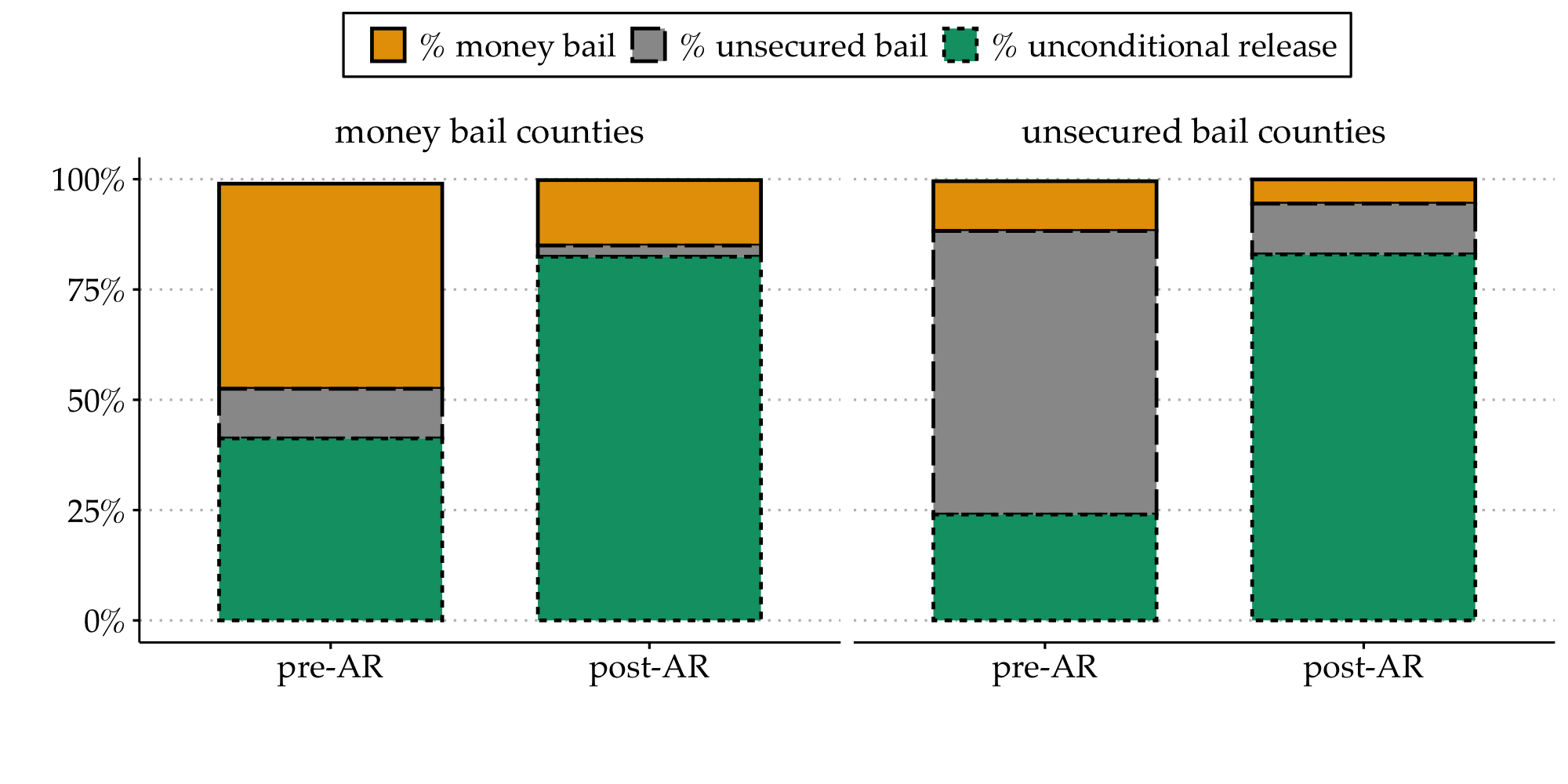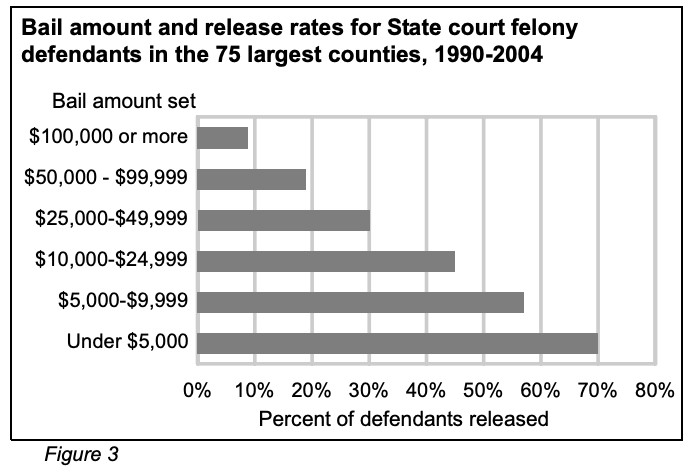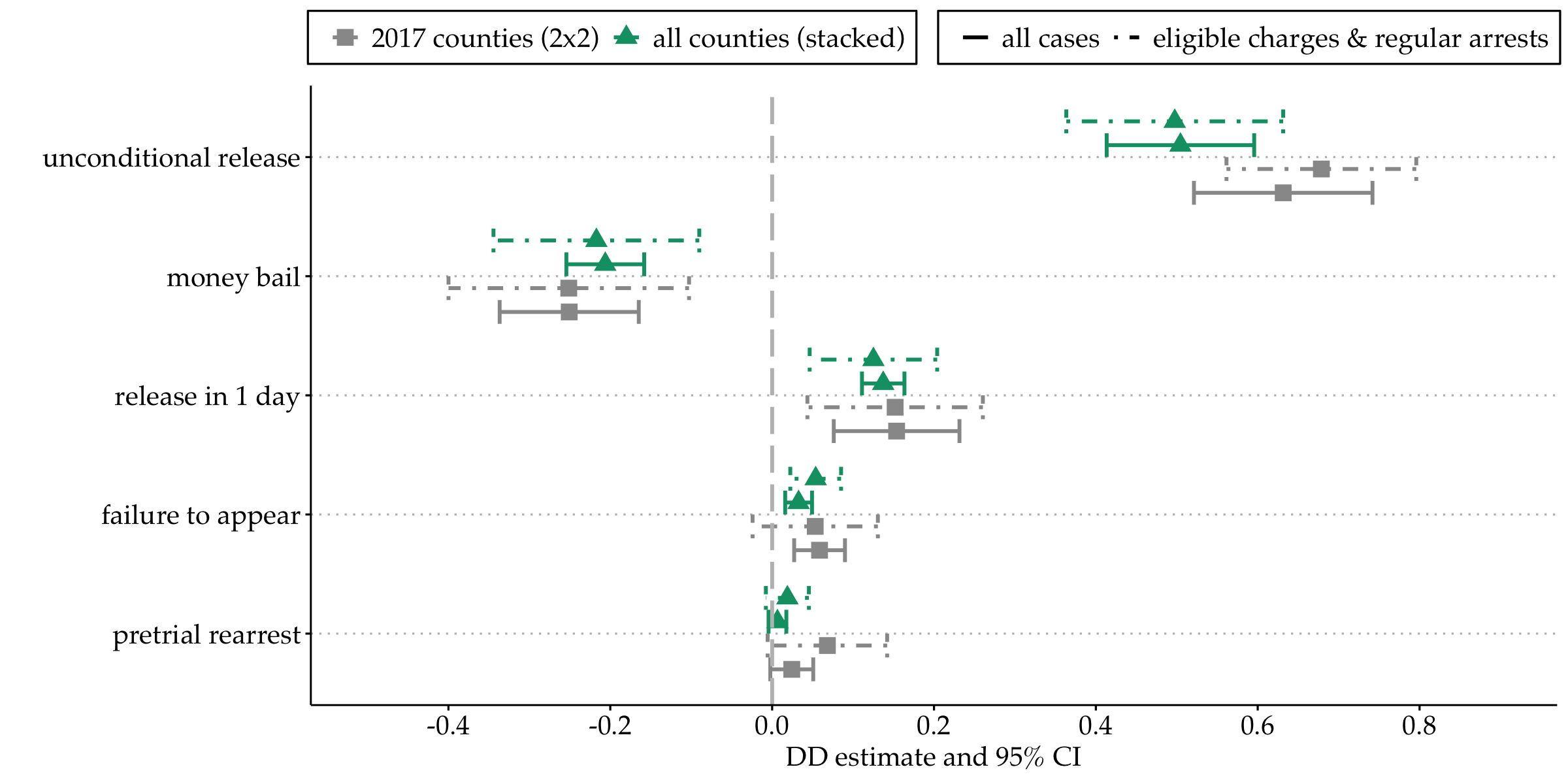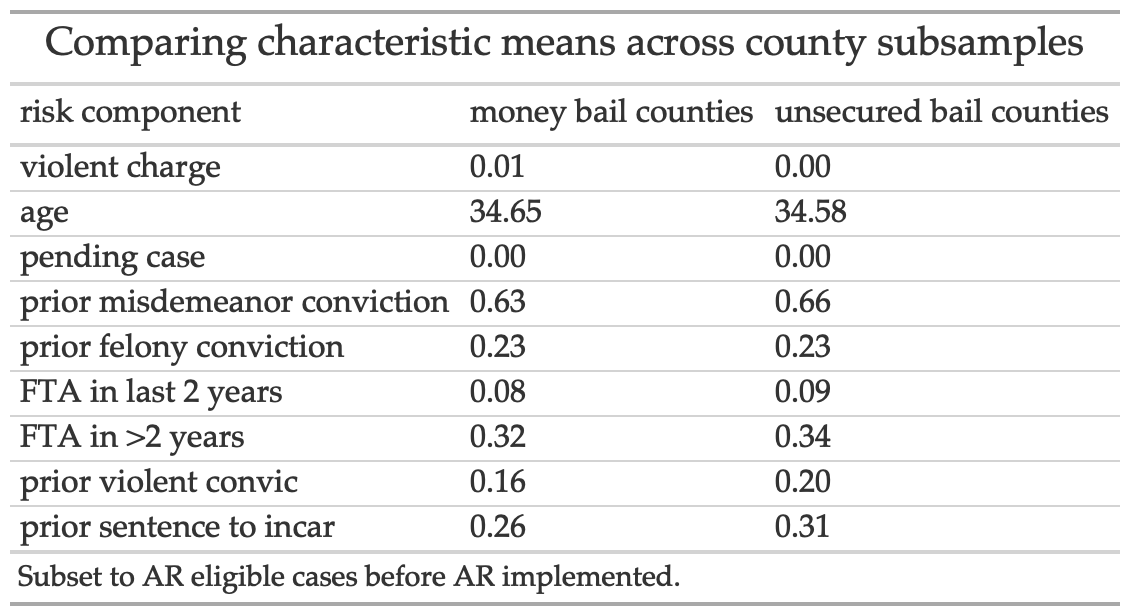No Money Bail, No Problems?
Trade-offs in a Pretrial Automatic Release Program
Alex Albright
July 2022
Incarceration before any conviction is common in the US
65% of people in US jails in are pretrial detention (~500,000 people) (BJS, 2009)

Thank you to the organizing much for having me. I'm thrilled to be part of such an exciting group of speakers. I'm Alex Albright and I'm an incoming Economist at the Opportunity and Inclusive Growth Institute at the Minneapolis Fed.
This paper is on money bail reform and trade-offs in an automatic release program
FIRST SLIDE:
the num of ppl in pretrial detention increased 6 fold over past 40 years
Incarceration before any conviction is common in the US
65% of people in US jails in are pretrial detention (~500,000 people) (BJS, 2009)

Pretrial detention is expensive:
Pretrial jailing costs $15 billion per year (Rabuy, 2017)
Detention hurts detainees' legal/labor market outcomes (Dobbie, Goldin, Yang (2018); Heaton, Mayson, Stevenson (2017); Leslie, Pope (2017); Gupta, Hansman, Frenchman (2016))
transition: how do people end up in pretrial detention...?
Bail system in the US
Arrest ⟶ Bail conditions set ⟶ Conviction determination
- Bail's purpose: ensure court appearance + public safety (ABA Pretrial Standards)
Bail system in the US
Arrest ⟶ Bail conditions set ⟶ Conviction determination
- Bail's purpose: ensure court appearance + public safety (ABA Pretrial Standards)
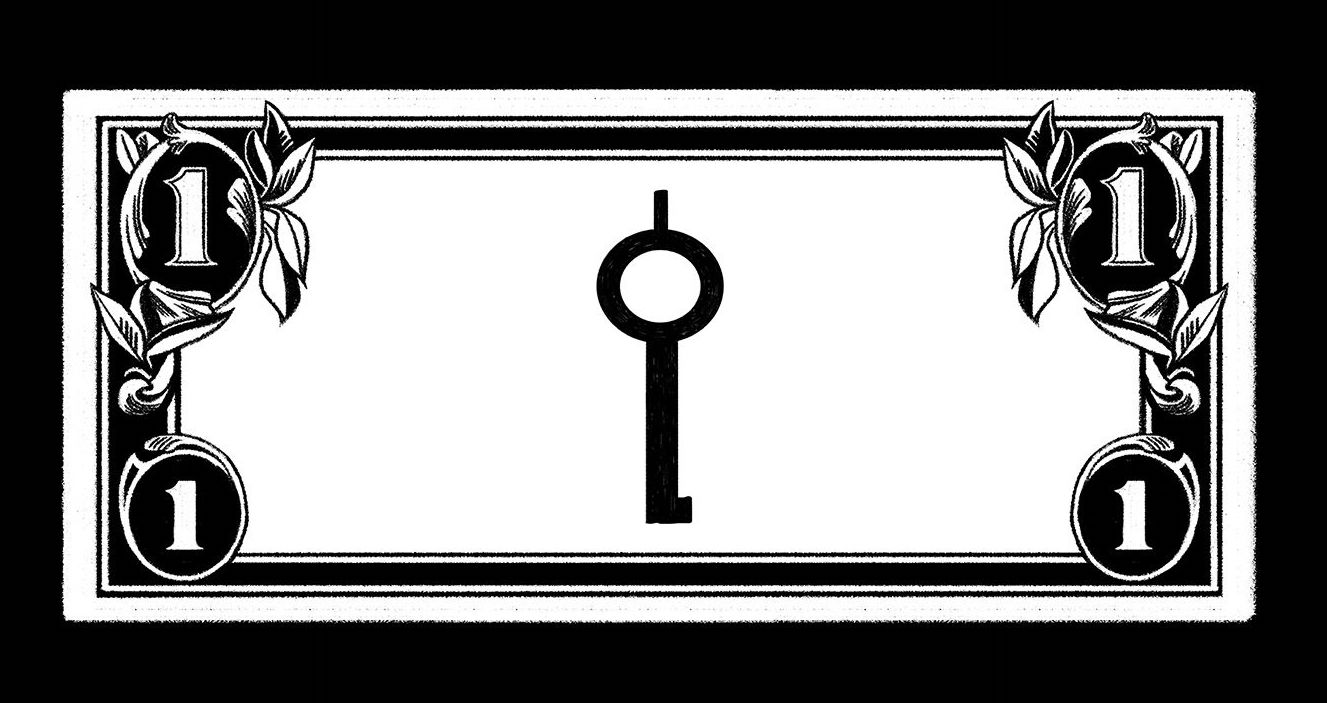 (Design: Erin Lux)
(Design: Erin Lux)
Most salient example: money bail (deposit sum for jail release)
financial incentive to: appear in court / not offend
can induce pretrial detention
(1) financial incentive => you've put down money, you want to be able to get the money bail
(2) detention => if you don't put down the money, you stay in jail
Transition: The large scale of pretrial detention coupled with the usage of money bail = fueled recent bail reform wave across the US
Jurisdictions across the US are reforming bail systems
2017-Present: New Jersey, New Mexico, Kentucky, Connecticut, New Orleans, Alaska, Atlanta, Philadelphia, New York, Illinois, and more
Jurisdictions across the US are reforming bail systems
2017-Present: New Jersey, New Mexico, Kentucky, Connecticut, New Orleans, Alaska, Atlanta, Philadelphia, New York, Illinois, and more
goal: reduce detention
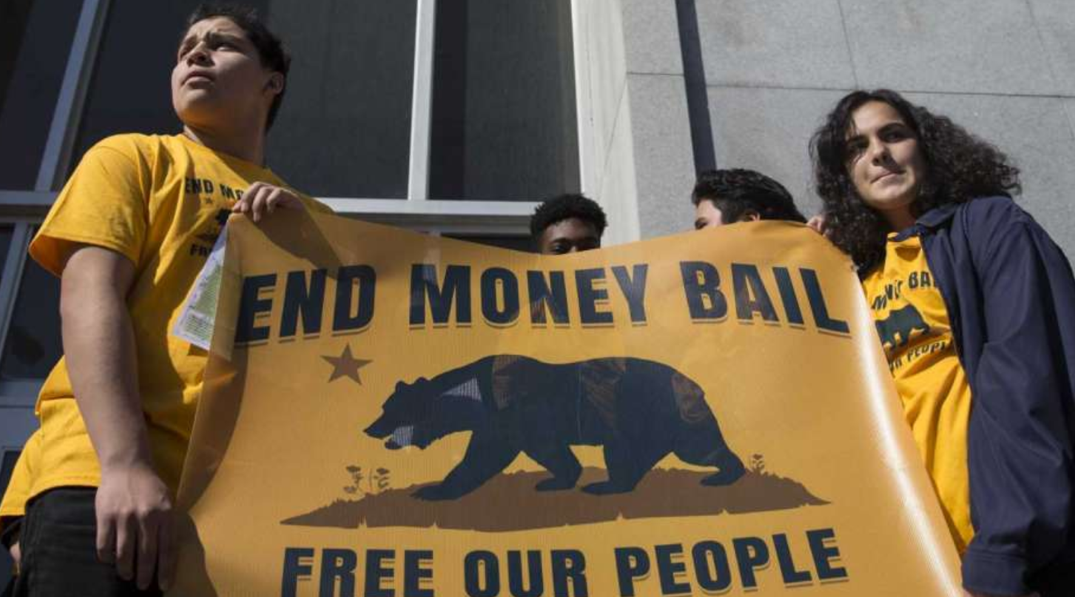
worry: increase misconduct*
 *i.e., court non-appearance/rearrest
*i.e., court non-appearance/rearrest
While the specifics of the reforms vary by place, the general theme is moving towards a more lenient bail system -- moving away from money bail specifically
The goals and concerns around these reforms are consistent...
This project
Question: What are the effects of narrowing the use of money bail?
- Corollary: what is the trade-off between detention and misconduct?
This project
Question: What are the effects of narrowing the use of money bail?
- Corollary: what is the trade-off between detention and misconduct?
Setting: Automatic Release (AR) Program in Kentucky
- Instead of judges deciding on bail, automatically released eligible cases without financial bail conditions
→ 50 percentage point ↓ financial bail conditions
- Instead of judges deciding on bail, automatically released eligible cases without financial bail conditions
This project
Question: What are the effects of narrowing the use of money bail?
- Corollary: what is the trade-off between detention and misconduct?
Setting: Automatic Release (AR) Program in Kentucky
- Instead of judges deciding on bail, automatically released eligible cases without financial bail conditions
→ 50 percentage point ↓ financial bail conditions
- Instead of judges deciding on bail, automatically released eligible cases without financial bail conditions
Empirical design: differences-in-differences (DD)
- leveraging variation in eligibility and time
AR program is automatic and takes discretion away from judges (gives it a powerful first-stage, 50 pp)
DD:
- for any county, there are ineligible and eligible cases for the program
- ineligible = control group
- eligible = treatment group (change in bail at time of policy)
Preview of Results
(1) What are the program effects on detention and misconduct?
detention hours decrease by 42% [Annually, 25 less person-years]
court non-appearance increases by 3.3 p.p. [Annually, 364 more instances]
insignificant effects on pretrial rearrest
Preview of Results
(1) What are the program effects on detention and misconduct?
detention hours decrease by 42% [Annually, 25 less person-years]
court non-appearance increases by 3.3 p.p. [Annually, 364 more instances]
insignificant effects on pretrial rearrest
Do these effects constitute a justified trade-off?
- trade-off is justified if 1 court non-appearance costs less than 26 detention days
these directions are perhaps not surprising... fta increases, detention decreases... where do we go from here. in a simplified cost-benefit framework, whether the program is desirable or not hinges on how we trade off between two objects: misconduct and detention...
Preview of Results
(2) Did AR increase new arrests?
- ie., is there evidence were there general equilibrium effects of more lenient bail?
- no evidence that AR take-up impacted total arrests
Preview of Results
(2) Did AR increase new arrests?
- ie., is there evidence were there general equilibrium effects of more lenient bail?
- no evidence that AR take-up impacted total arrests
(3) Did AR impact racial and/or socioeconomic gaps?
- AR closes gaps in money bail and pretrial detention between:
- Black and white people
- employed and unemployed people
Preview of Results
(2) Did AR increase new arrests?
- ie., is there evidence were there general equilibrium effects of more lenient bail?
- no evidence that AR take-up impacted total arrests
(3) Did AR impact racial and/or socioeconomic gaps?
- AR closes gaps in money bail and pretrial detention between:
- Black and white people
- employed and unemployed people
(4) What primary mechanism drives AR effects?
- Substitution away from money bail
On (2) is there reduced deterrence of low-level offenses? ie, more lenient bail doesn't seem to have lead to more choices to commit offenses
Does AR impact new offending? =>
if I know bail is quite lenient for certain offenses and that bail is a big component of the expected punishment, do I offend more?
On (3), another major motivating factor for reforming the bail system is the possibility of alleviating inequality in CJS
Related Literature & Contribution
- Effects of modern bail reform efforts (Ouss and Stevenson 2022; Skemer, Redcross, and Bloom 2020; Albright, 2019; Stevenson, 2018)
- Pretrial behavioral responses: bail conditions (Dobbie, Goldin, and Yang 2018; Gupta, Hansman, and Frenchman 2016; Abrams and Rohlfs 2011; Helland and Tabarrok 2004; Myers Jr 1981), court reminders (Emanuel and Ho 2020; Fishbane, Ouss, and Shah 2020)
- Interplay between the criminal justice system and financial well-being: pretrial detention (Dobbie, Goldin, and Yang 2018; Heaton, Mayson, and Stevenson 2017; Leslie and Pope 2017), fines/fees (Finlay, Gross, Luh, Mueller-Smith 2022; Pager, Goldstein, Ho, Western 2022; Giles, 2021; Mello 2021), incarceration (Aneja and Avenancio-León 2020)
Related Literature & Contribution
- Effects of modern bail reform efforts (Ouss and Stevenson 2022; Skemer, Redcross, and Bloom 2020; Albright, 2019; Stevenson, 2018)
- Pretrial behavioral responses: bail conditions (Dobbie, Goldin, and Yang 2018; Gupta, Hansman, and Frenchman 2016; Abrams and Rohlfs 2011; Helland and Tabarrok 2004; Myers Jr 1981), court reminders (Emanuel and Ho 2020; Fishbane, Ouss, and Shah 2020)
- Interplay between the criminal justice system and financial well-being: pretrial detention (Dobbie, Goldin, and Yang 2018; Heaton, Mayson, and Stevenson 2017; Leslie and Pope 2017), fines/fees (Finlay, Gross, Luh, Mueller-Smith 2022; Pager, Goldstein, Ho, Western 2022; Giles, 2021; Mello 2021), incarceration (Aneja and Avenancio-León 2020)
Contribution: direct evidence on effects of a unique policy-relevant program
- general equilibrium effects (responses by CJS actors, defendants)
- strong first-stage (due to automatic nature)
- policy relevance (other jurisdictions considering AR; low-level cases)
(1) Lots of prior studies use partial equilibrium variation to estimate effects of bail (eg, judge IVs)
But policy relevant = whole jurisdiction changes policy
(Ouss and Stevenson paper = most related)
(2) In my context, the program was automatic, making it a powerful setting for studying bail reform
The usage of financial conditions dropped by more than 50 percentage points for the eligible population
(3) Other jurisdictions considering AR; Low-level offenses = target population for reducing the scale of the bail system
(Nice feature of this is that I'm estimating effects for people arrested for low-level rather than some average person arrested)
Kentucky Automatic Release Program
Status quo: judges set bail conditions

Status quo: judges set bail conditions

- Unsecured bail ex post requirement
- Money bail ex ante requirement
Status quo: judges set bail conditions

- If assigned money bail, there is some chance of detention
- If not, released
Status quo: judges set bail conditions

- If detained, no chance of misconduct
- If released, some chance of misconduct
Status quo: judges set bail conditions

If commit misconduct, (1) face baseline penalties (e.g., face warrant, fines) &
(2) forfeit bail amount (if any)
highlight that without bail (unconditional release),
- there are still penalties for misconduct
- there are just no BAIL penalties
AR program averts judge decision-making process

If eligible for AR, administrative assignment to unconditional release
(no judge involved)
no judge involved = makes this program unique
usually with bail reform judges get to keep their discretion
Transition: what is an eligible case???
Eligibility requirements
regular arrest (68% of cases)
regular arrest = not re-arrest (due to bench warrant, violation of conditions)non-sexual/non-violent misdemeanors (38% of cases)
common examples: driving offenses (w/out insurance, suspended license, no license), drug paraphernalia (buy/possess), shoplifting, disorderly conduct/public intoxicationlow enough defendant risk score (73% of cases)
score must be below 8 on a scale of 2-12 [risk score calculation]
State Supreme Court's Jan 2017 eligibility definition, which covers most (99/120) counties
Data + Empirical Strategy
Data
Use Kentucky Administrative Office of the Courts files to construct a case-level dataset, including:
- date initial bail set (between July 1, 2014 and November 30, 2017)
- initial bail conditions
- time between booking and eventual release from jail
- failure to appear in court
- pretrial rearrest
Data
Use Kentucky Administrative Office of the Courts files to construct a case-level dataset, including:
- date initial bail set (between July 1, 2014 and November 30, 2017)
- initial bail conditions
- time between booking and eventual release from jail
- failure to appear in court
- pretrial rearrest
Challenge: No official record of AR eligibility by case
Data
Use Kentucky Administrative Office of the Courts files to construct a case-level dataset, including:
- date initial bail set (between July 1, 2014 and November 30, 2017)
- initial bail conditions
- time between booking and eventual release from jail
- failure to appear in court
- pretrial rearrest
Challenge: No official record of AR eligibility by case
- Solution: use observable data on arrests, charges, scores to tag eligibility (can be imperfect if: unobservables lead to exemptions or charge codes vary)
don't perfectly observe eligibility but I'll show you later that my tagging seems to do a good job at getting at true eligibility
What are the effects of AR on
bail, release, and misconduct?
How did AR affect
bail conditions and release?
AR drives large shift towards unconditional release (as expected)
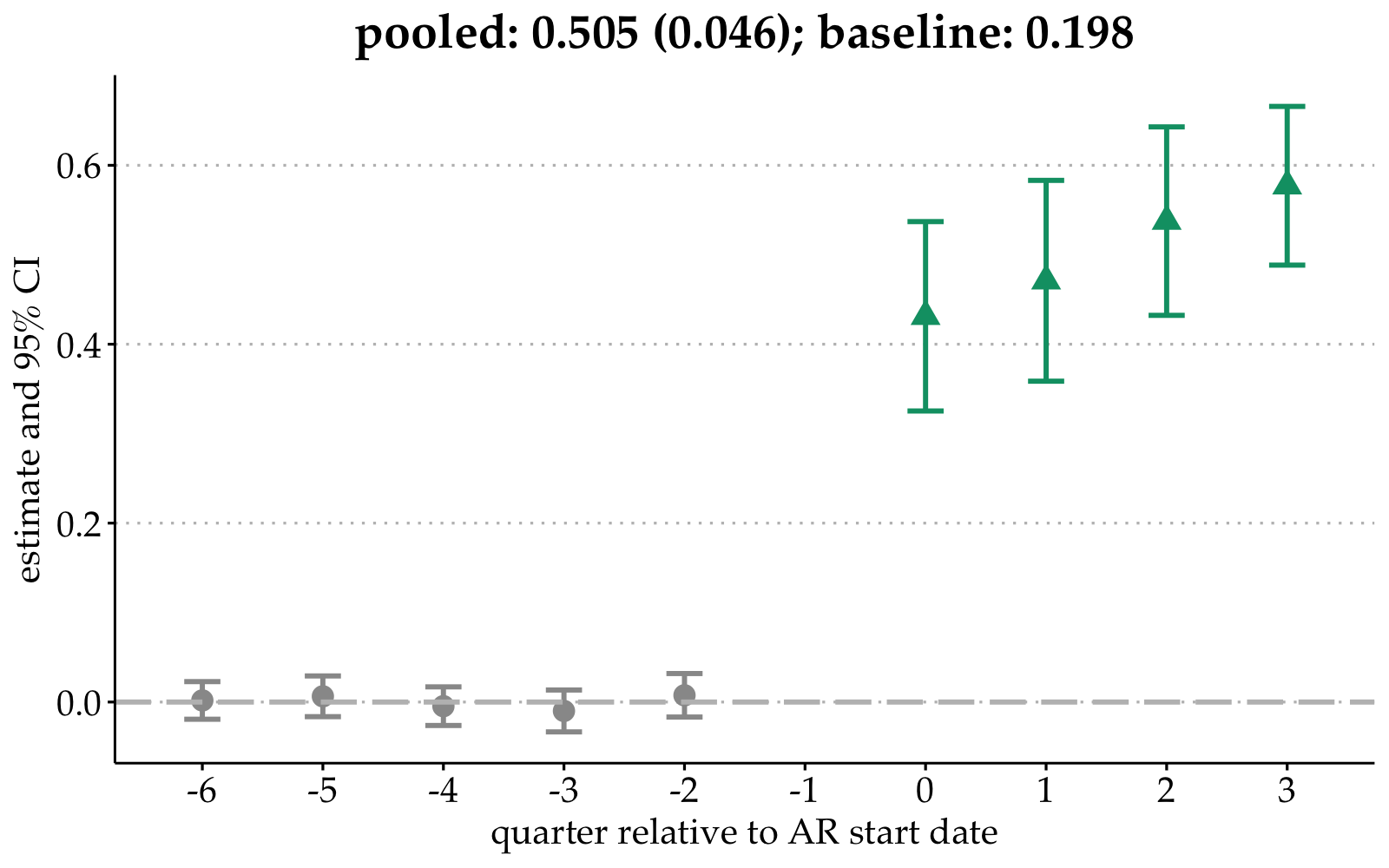
this was the intent of the policy!
we might think that most of this will come from substitution away from unsecured bail and none will come from money bail (if we think low-risk cases don't get money bail)
40% of that is substitution away from money bail

Money bail amount distribution shifts left for eligible cases
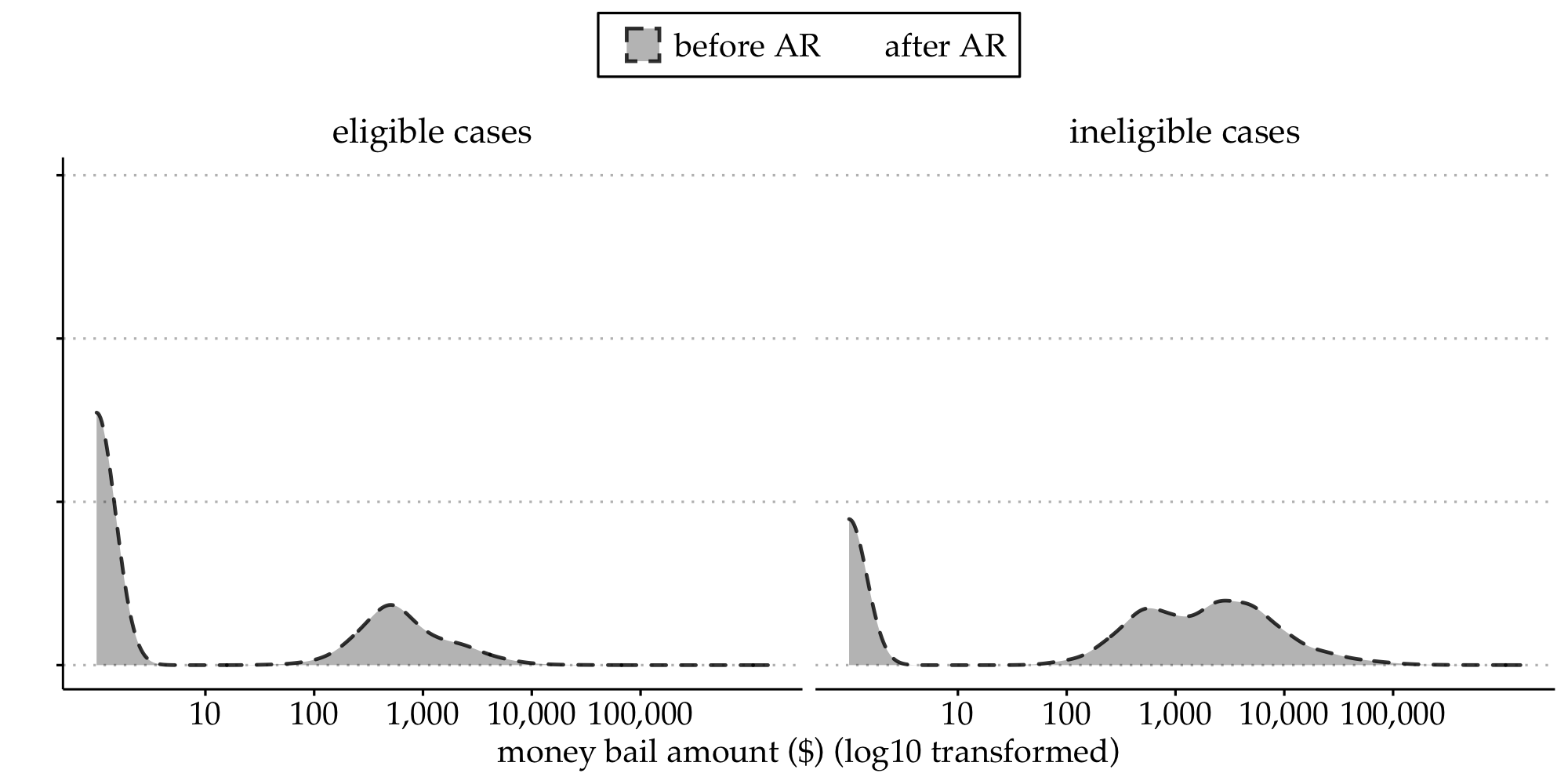 (unconditional release or unsecured bail means $0 money bail)
(unconditional release or unsecured bail means $0 money bail)
not seeing some countervailing effect of harsher treatment to ineligible cases
Money bail amount distribution shifts left for eligible cases
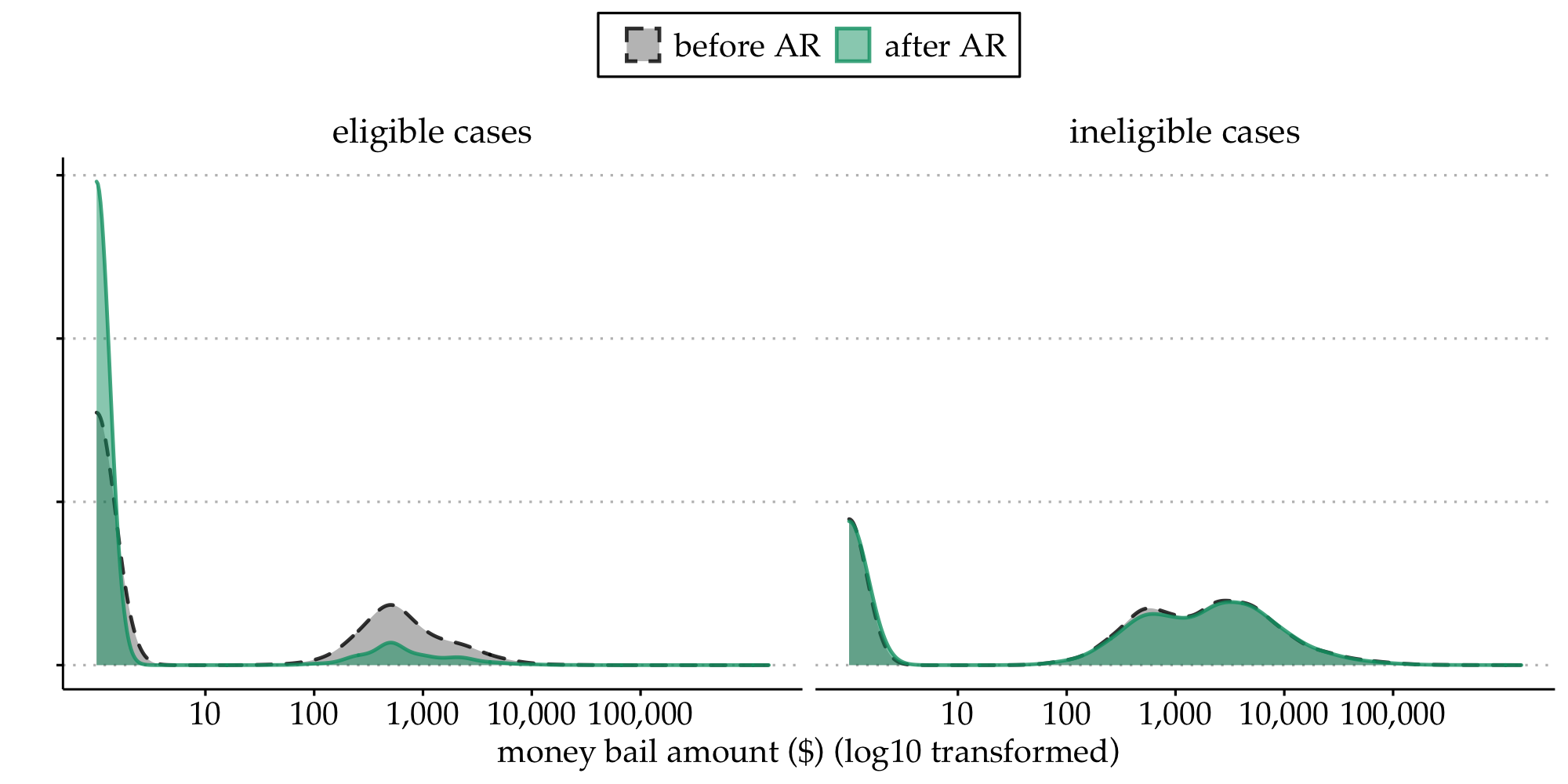 (unconditional release or unsecured bail means $0 money bail)
(unconditional release or unsecured bail means $0 money bail)
$ required for release ↓ by 77% (baseline mean: $360) [DD plot]
Annually, this means $3.2 million less required from the population
Note there are no unintended effects of AR on judges who still see cases. (Might have thought they would be harsher and this would somewhat offset impacts of AR program)
Release in 1 day ↑ 13.7 ppts
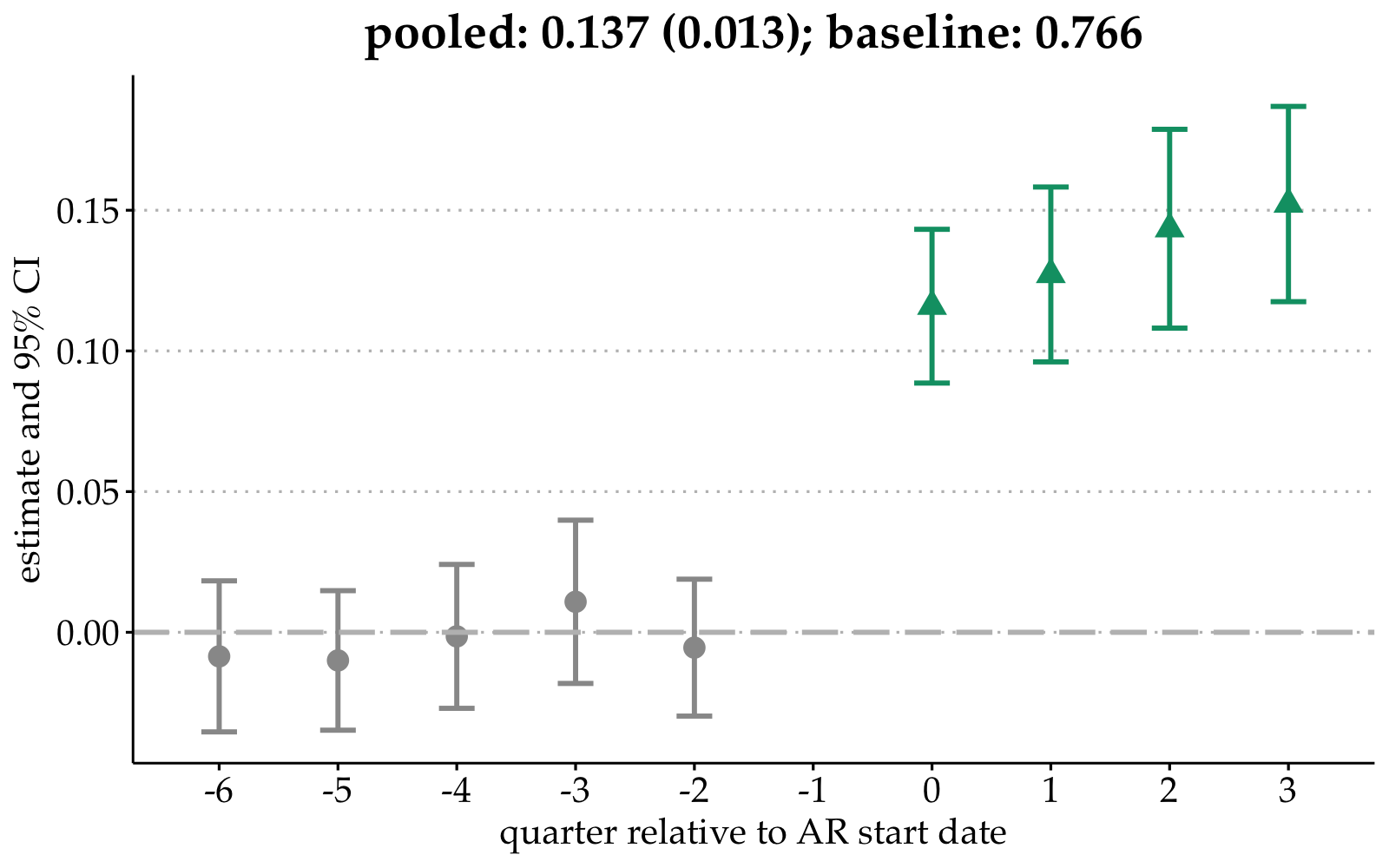
- large effects despite low baseline $ bail amounts; consistent w/ binding liquidity constraints
Detention hours distribution shifts left for eligible cases
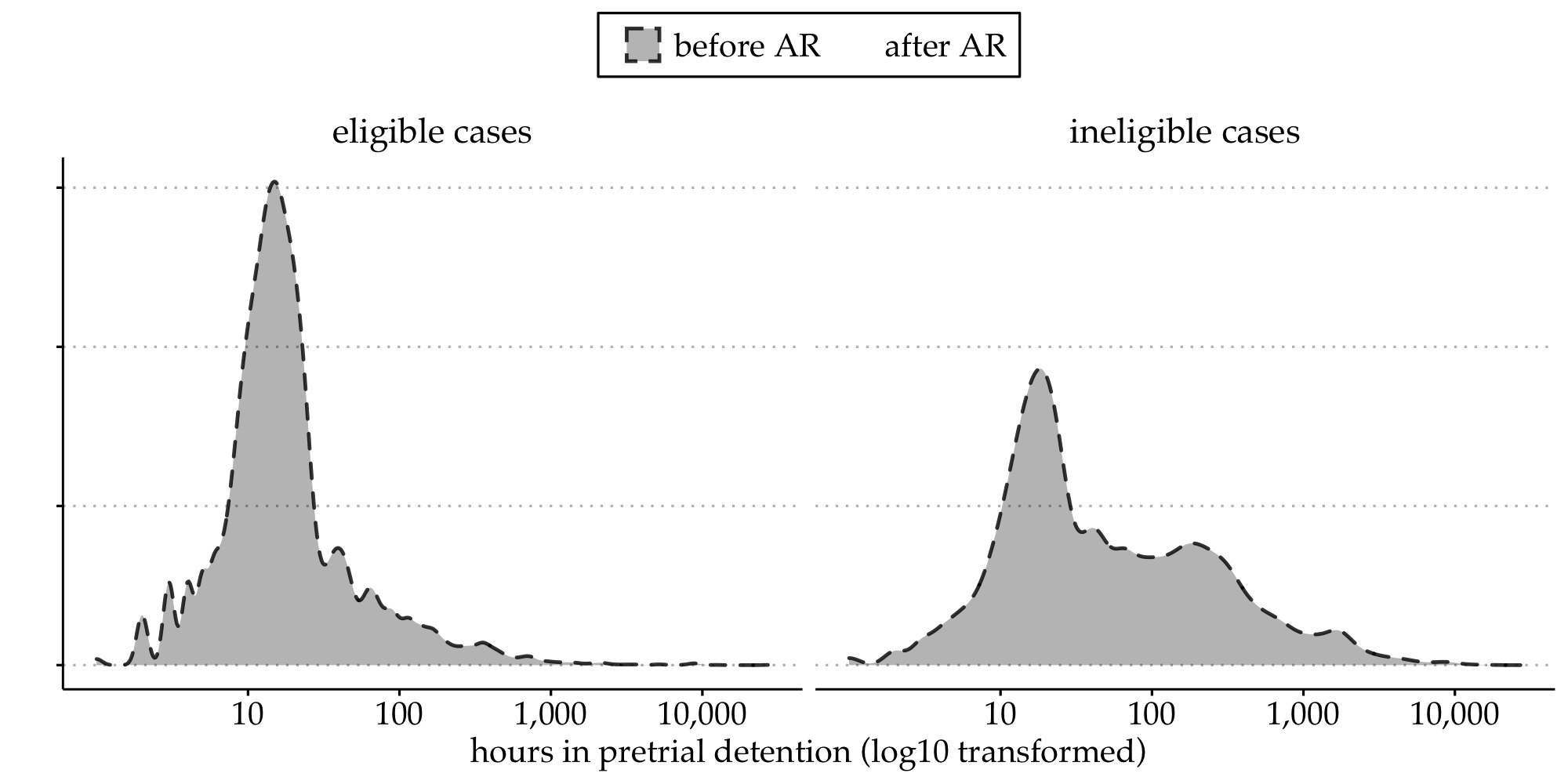
Detention hours distribution shifts left for eligible cases
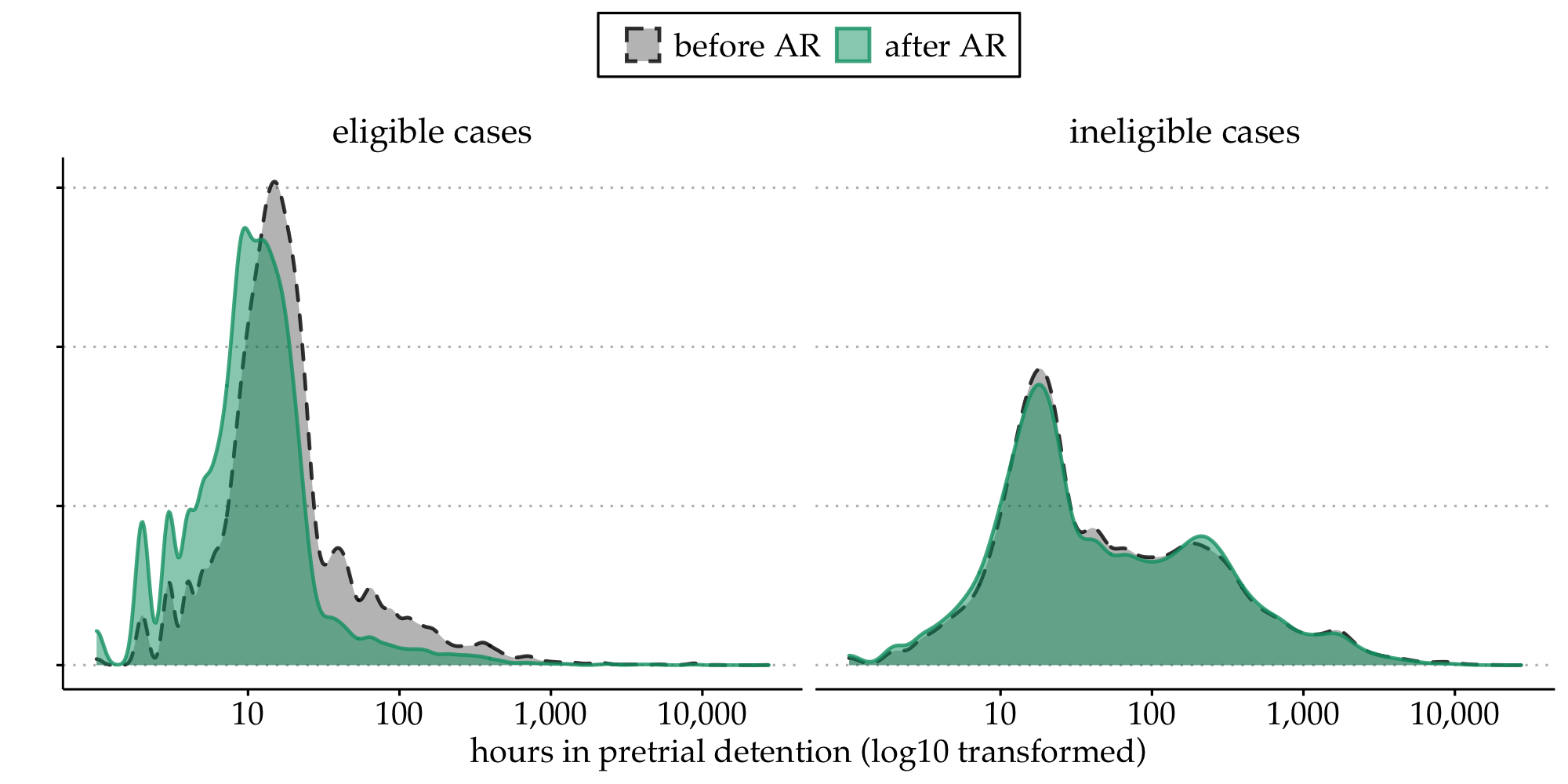
Hours in detention decreased by 42% (baseline mean: 49 hours) [DD plot]
Annually, 223,000 less hours in detention → 25 less person-years
How did AR affect misconduct?
Failure to appear in court increases 3.3 ppts
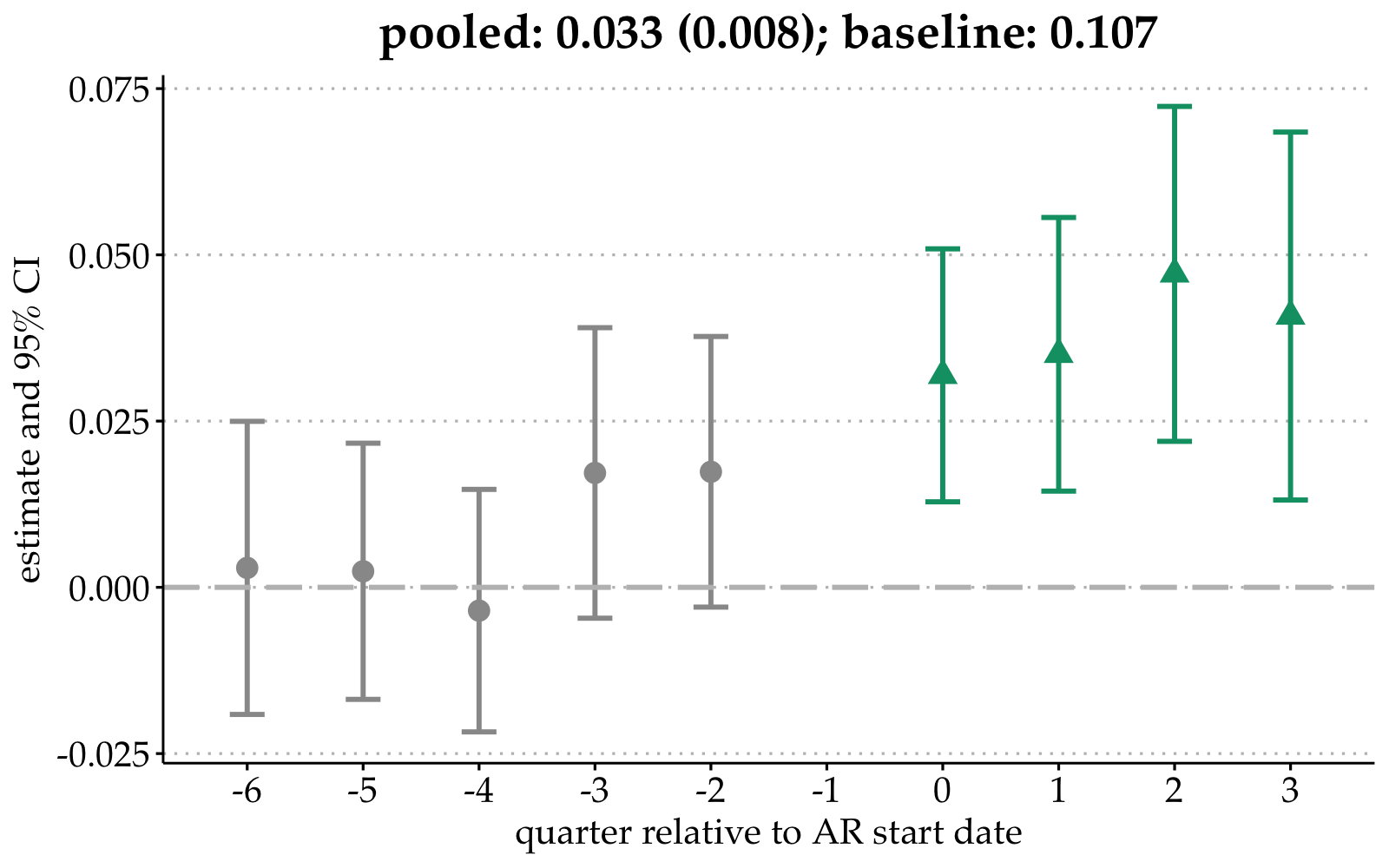
Point estimate → annually, ~364 more non-appearances
Effects on pretrial rearrest are insignificant
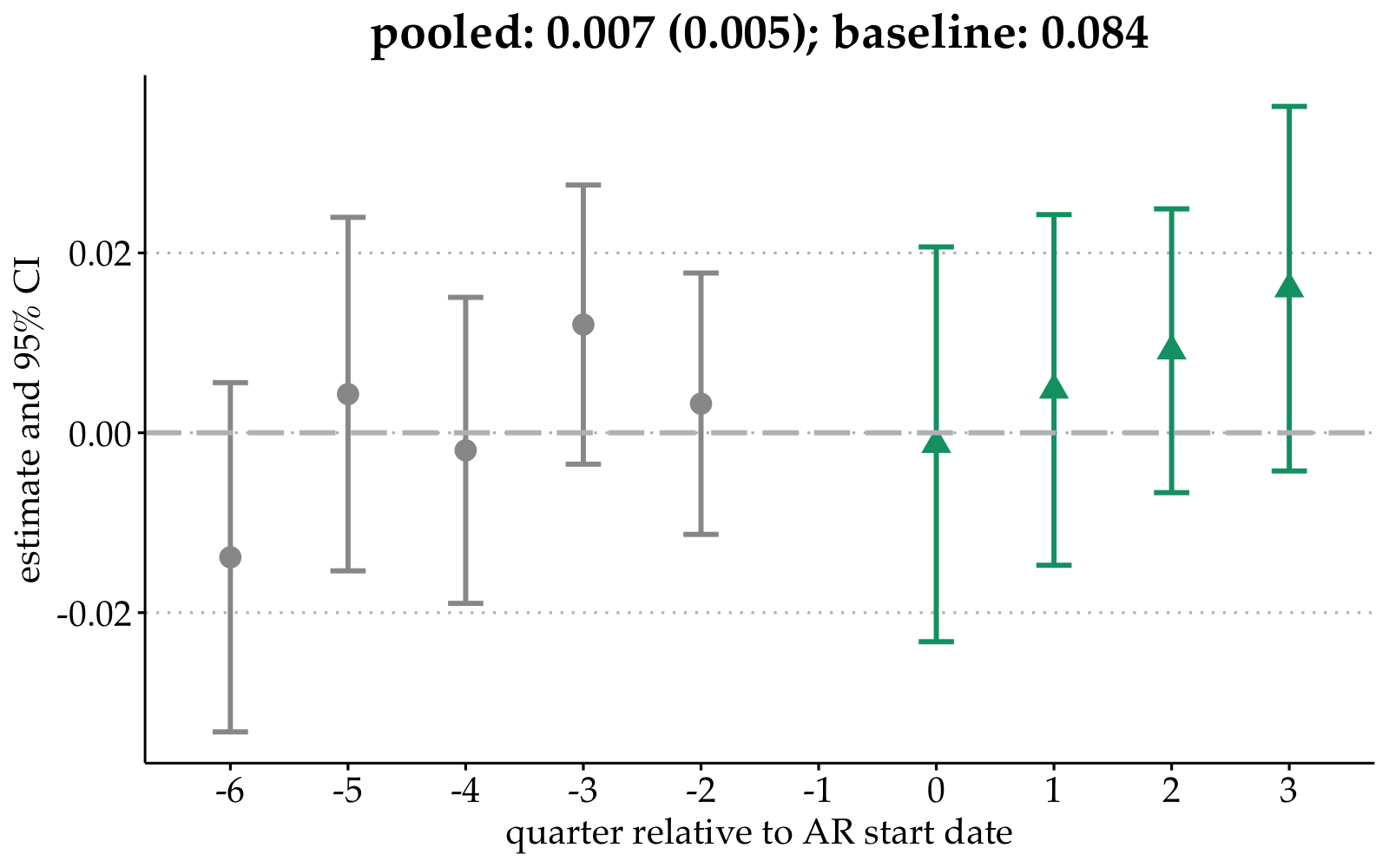 Pretrial rearrest 95% CI includes: ↓ 0.28 ppts & ↑ 1.68 ppts
Pretrial rearrest 95% CI includes: ↓ 0.28 ppts & ↑ 1.68 ppts
Point estimate → annually, ~79 more non-appearances
Effects on violent pretrial rearrest are insignificant + small
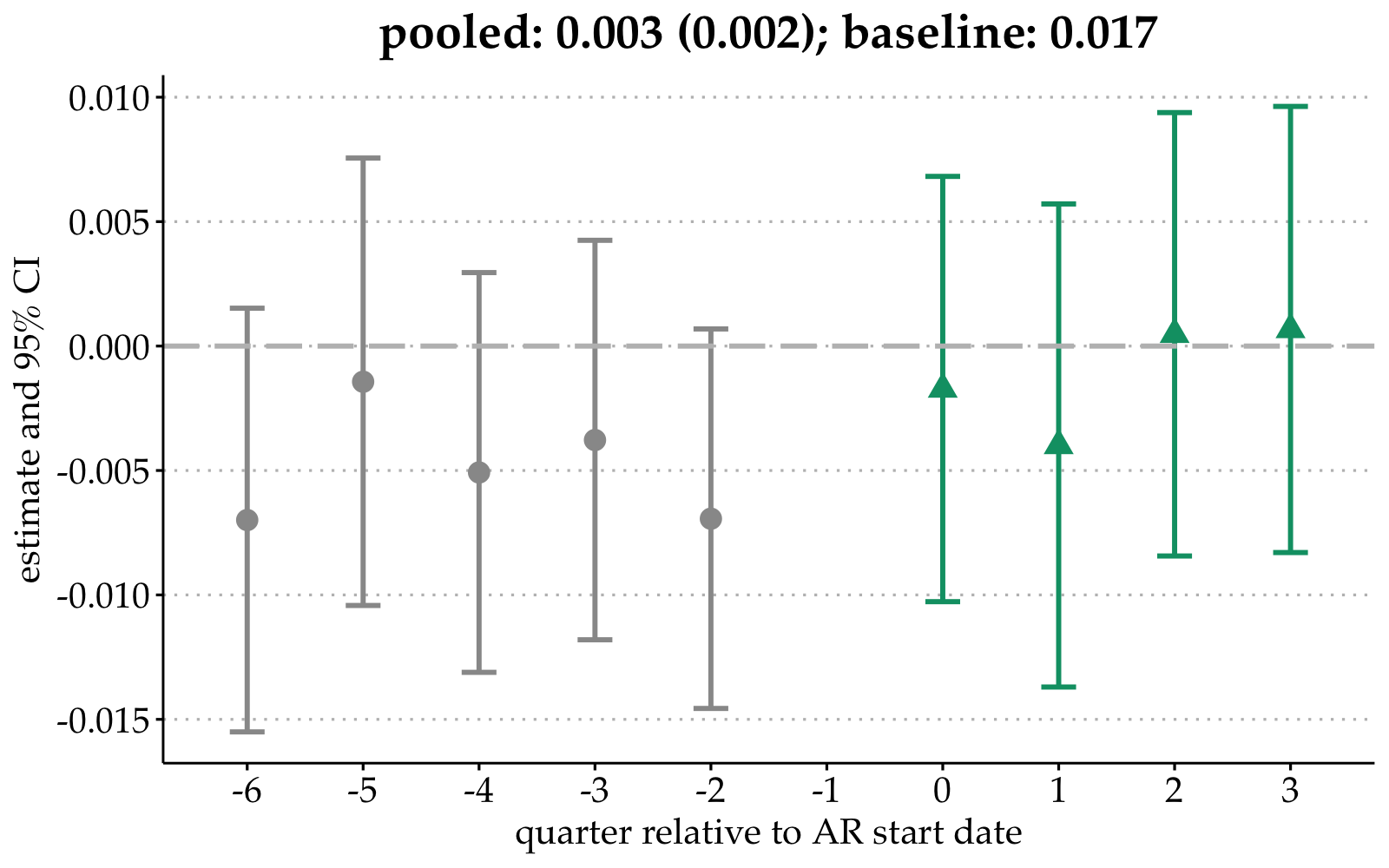 Top of 95% CI: ↑ 0.6 ppts
Top of 95% CI: ↑ 0.6 ppts
- can rule out even small increases in violent rearrests for this population
Point estimate → annually, ~34 more non-appearances
The detention-misconduct trade-off
Do these effects make for a desirable trade-off?
- Legal objective of bail is to minimize pretrial detention and misconduct
- Assume those two quantities are what a social planner cares about
Do these effects make for a desirable trade-off?
- Legal objective of bail is to minimize pretrial detention and misconduct
- Assume those two quantities are what a social planner cares about
Assuming total quantities is what matters,
9,187 less detention days vs.
364 more non-appearances
Assuming constant costs,
26 detention days vs. 1 FTA
Do these effects make for a desirable trade-off?
- Legal objective of bail is to minimize pretrial detention and misconduct
- Assume those two quantities are what a social planner cares about
Assuming total quantities is what matters,
9,187 less detention days vs.
364 more non-appearances
Assuming constant costs,
26 detention days vs. 1 FTA
Alternative frameworks:
21 detention days vs.
1 any misconduct
118 detention days vs.
1 rearrest
273 detention days vs.
1 violent rearrest
none of these directions of effects are shocking but what do we make of them? what do we learn from relative magnitudes?
Using year before AR as annual baseline
If we think the rearrest results are around 0, can focus on fta vs detention
If instead think rearrests are important and FTA not, can take upper estimate from 95% CI and calculate trade-off for rearrest vs. detention
However, one critique of these approaches looking at pretrial detention vs misconduct = we might care about more than just the legal objective... transition to next slide
Threats to Identification
What are threats to identification in this context?
Identification strategy (using eligibility and time): differences-in-differences
...but what if the AR program doesn't just change the bail process?
What are threats to identification in this context?
Identification strategy (using eligibility and time): differences-in-differences
...but what if the AR program doesn't just change the bail process?
What if it changes: (1) case composition (# of arrests)? or (2) the determination of eligibility?
=> how to test: leverage staggered timing (different identification strategy)
What are threats to identification in this context?
Identification strategy (using eligibility and time): differences-in-differences
...but what if the AR program doesn't just change the bail process?
What if it changes: (1) case composition (# of arrests)? or (2) the determination of eligibility?
=> how to test: leverage staggered timing (different identification strategy)
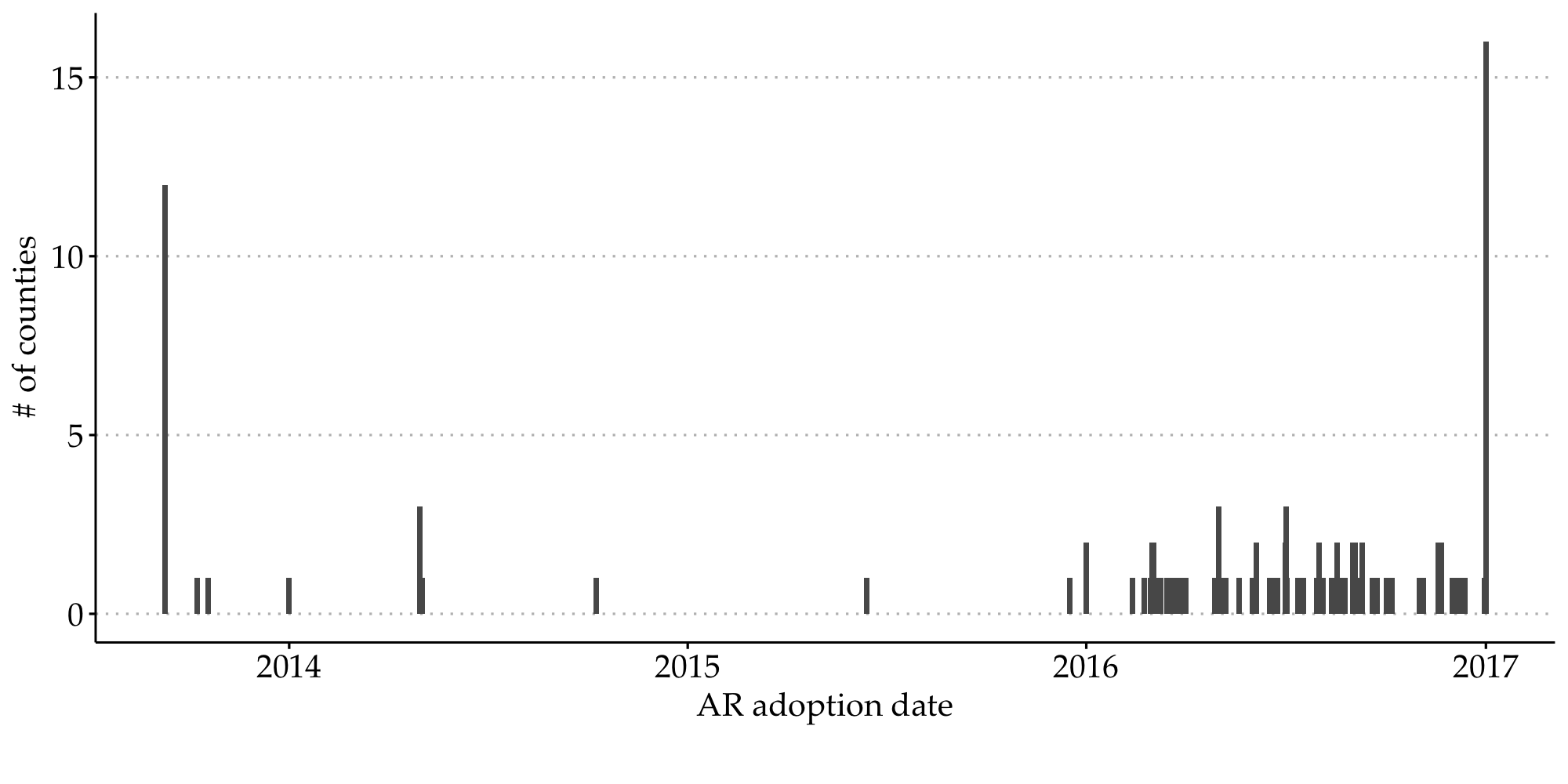
What are threats to identification in this context?
Identification strategy (using eligibility and time): differences-in-differences
...but what if the AR program doesn't just change the bail process?
What if it changes: (1) case composition (# of arrests)? or (2) the determination of eligibility?
=> how to test: leverage staggered timing (different identification strategy)

→ test for these changes using staggered timing of the AR program
overall offending: if lower bail means less deterrence for committing low-level offenses, then low-level offenses might increase as a result.... do they?
determining eligibility: CJS actors have control over some of the eligibility inputs... if some people don't like the program, they could make it harder to become eligible
issue in that case = eligible and ineligible groups aren't really the same before/after
Create balanced dataset of 99 counties over 14 relative quarters!!
Now the treatment of interest is not AR as applied to eligible cases in a county BUT RATHER AR as a policy implemented county by county!!
Effects on overall arrests are insignificant
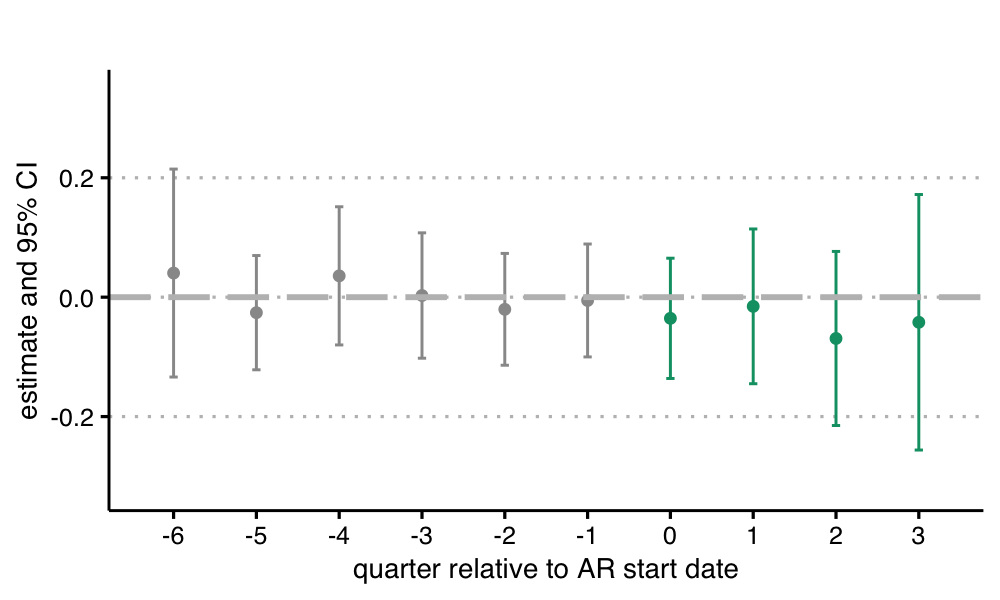
Interesting independent of relevance for identification
→No evidence that lenient bail for some cases increases arrests [by type]
Similar to a paper in Law + Econ Wednesday -- "modest reductions in police arrest activity, and particularly enforcement against low-level offending, may not come at the cost of rising crime rates."
INTERESTING INDEPENDENT OF ID STRATEGY! limited deterrence effects of lower bail for offending
- Callaway and Sant'Anna approach to deal with issues with TWFE
- Similar results for not-yet-treated units and last treated units as control group
- similar if do levels or logs
CS generates group-time average treatment effects (group defined by AR take-up date), time defined by month These are then aggregated into average treatment effects at different lengths of exposure to AR
Does AR induce manipulation of eligibility?
Two possible margins:
Strategic charging by police
- does share of cases with eligible charges change?
Strategic scoring by pretrial officers
- does share of cases with eligible risk scores change?
No strong evidence of police or pretrial officer manipulation
with eligible charges

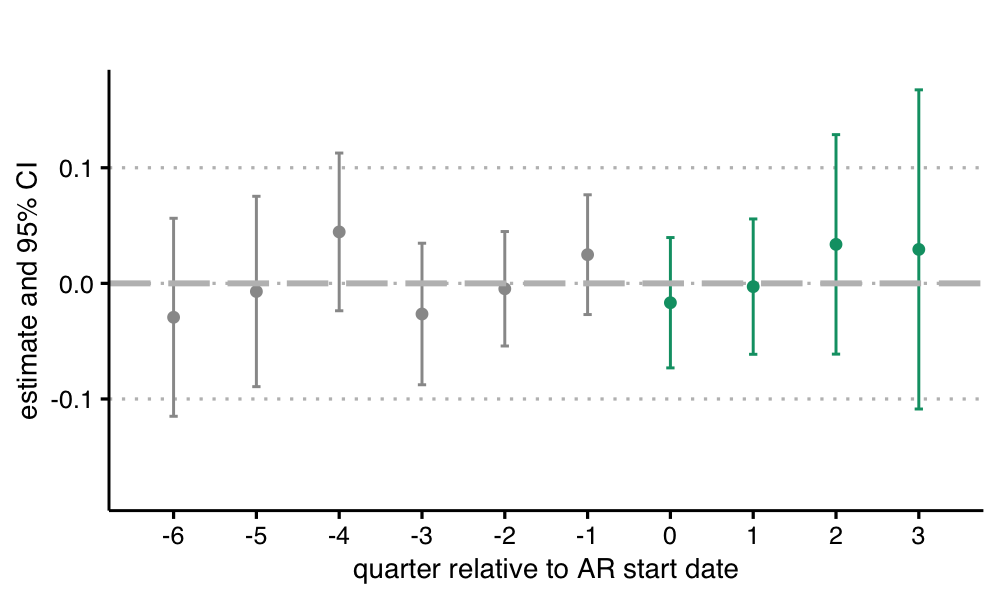
How did the program impact racial and socioeconomic gaps?
so far I have talked about effects on pretrial outcomes since the legal objective of bail is to min pretrial detention and misconduct....BUT...
reason this is important = this is a motivating reason for many reforms + is central to the policy conversation
AR reduces Black-white gaps for eligible cases
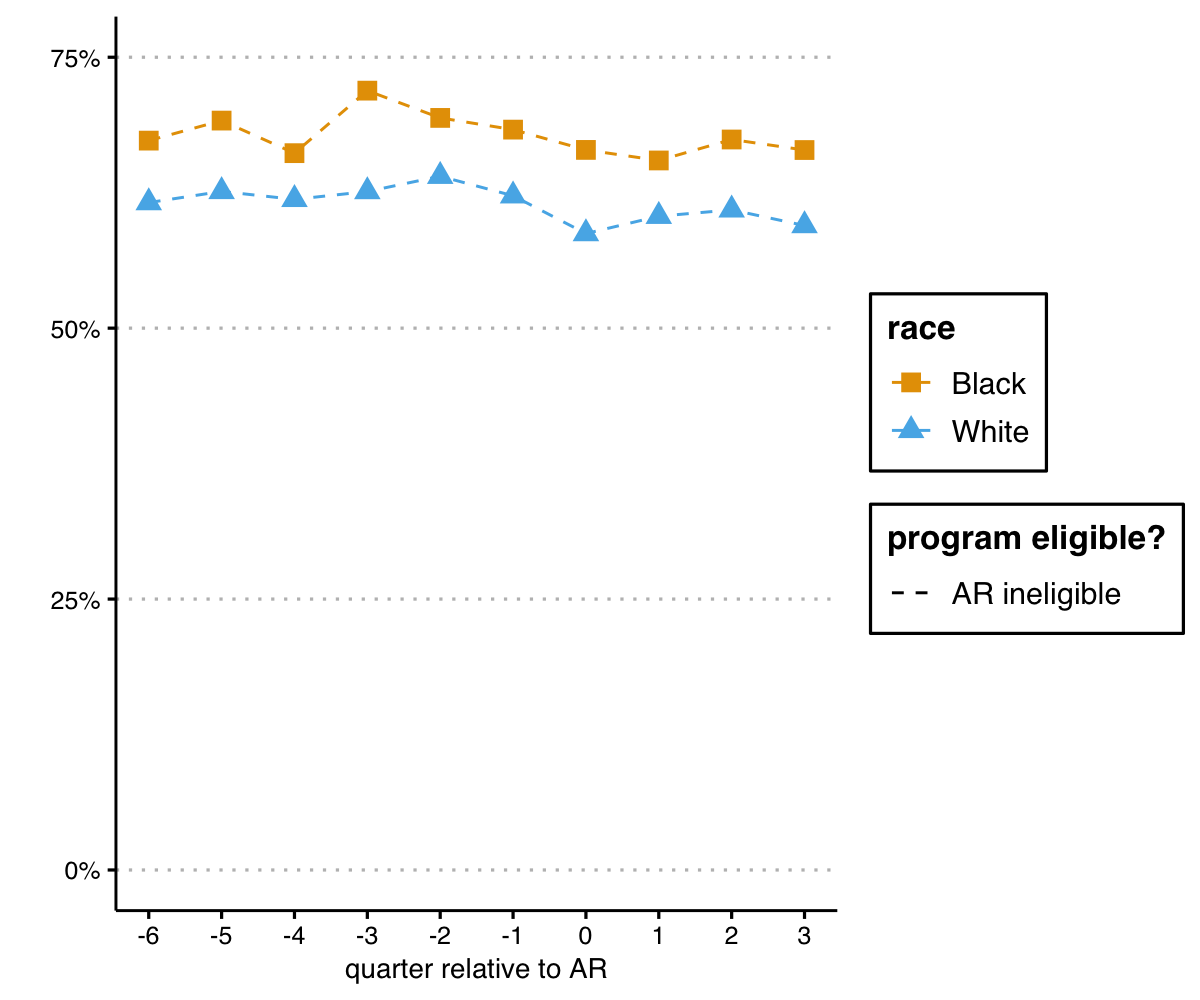
AR reduces Black-white gaps for eligible cases
 10 pp gap => 2 pp
10 pp gap => 2 pp
AR reduces Black-white gaps for eligible cases
 10 pp gap => 2 pp
10 pp gap => 2 pp

I am just showing raw plots since the gaps for ineligible cases stay consistent and my DD results are quite close to what you get from just simple raw plot arithmetic
AR reduces Black-white gaps for eligible cases
 10 pp gap => 2 pp
10 pp gap => 2 pp
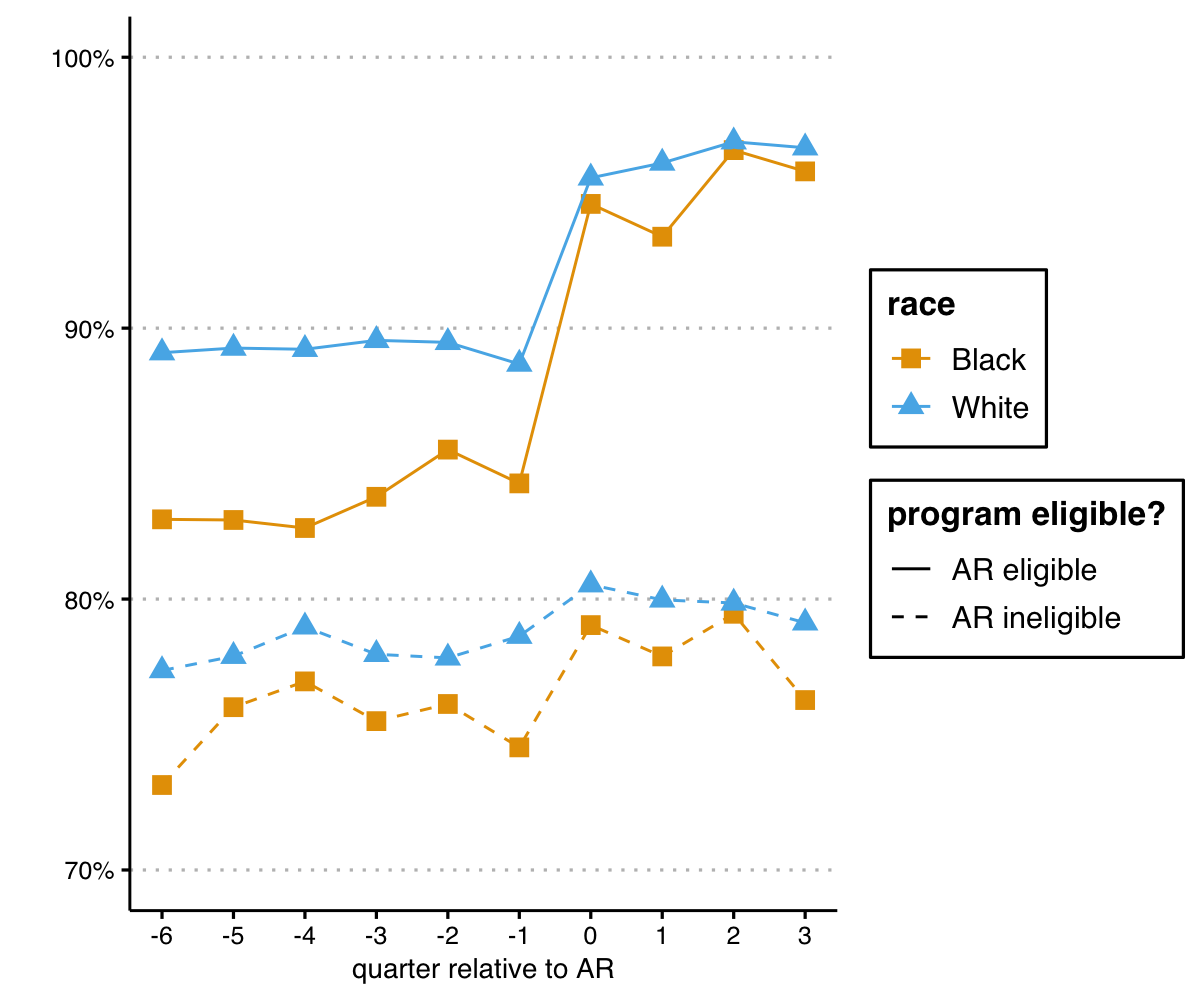 5.6 pp gap => 1.2 pp
5.6 pp gap => 1.2 pp
Effects are muted for the full population

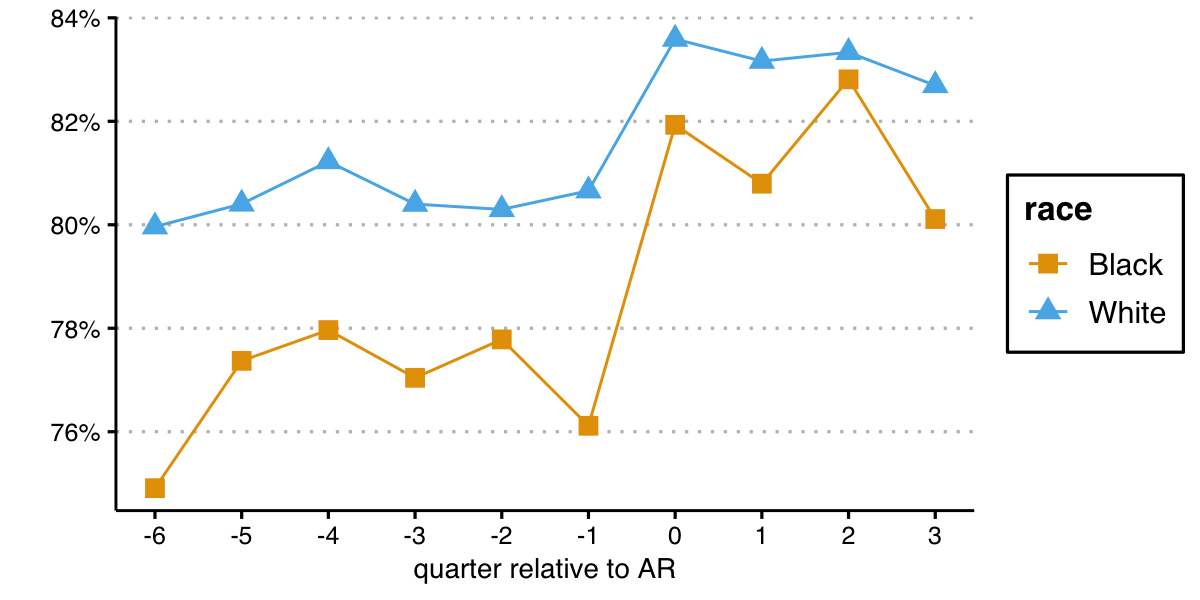
Why?
- only ~21% of cases are AR eligible
- white people are more likely to be AR eligible (21.5% vs. 19.1%)
- more likely to be arrested for eligible charges (35.3% vs. 32.6%),
more likely to have low enough risk scores (75.5% vs. 73.7%)
- more likely to be arrested for eligible charges (35.3% vs. 32.6%),
I am just showing raw plots since the gaps for ineligible cases stay consistent and my DD results are quite close to what you get from just simple raw plot arithmetic
AR reduces unemployed-employed gaps for eligible cases
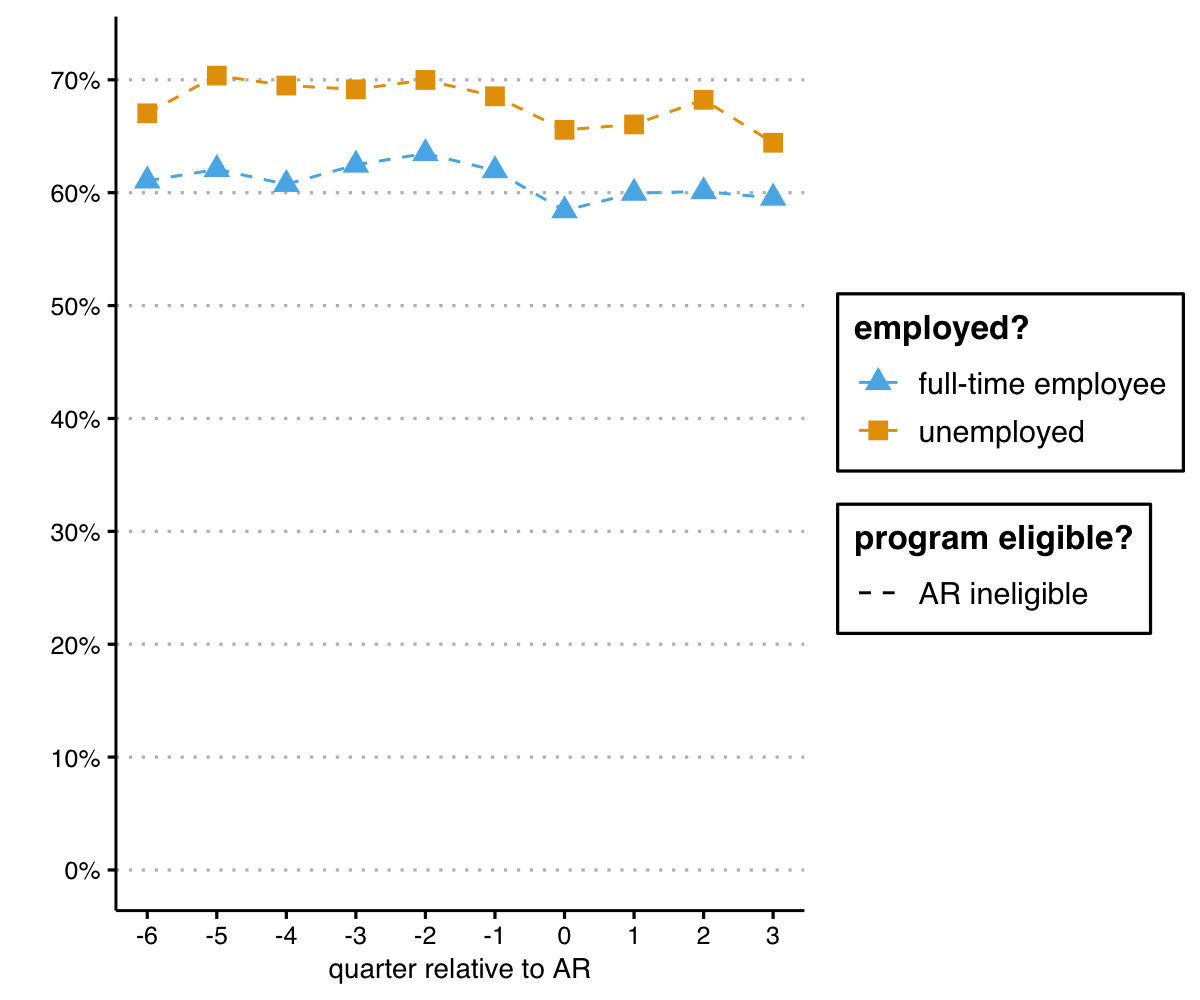
AR reduces unemployed-employed gaps for eligible cases
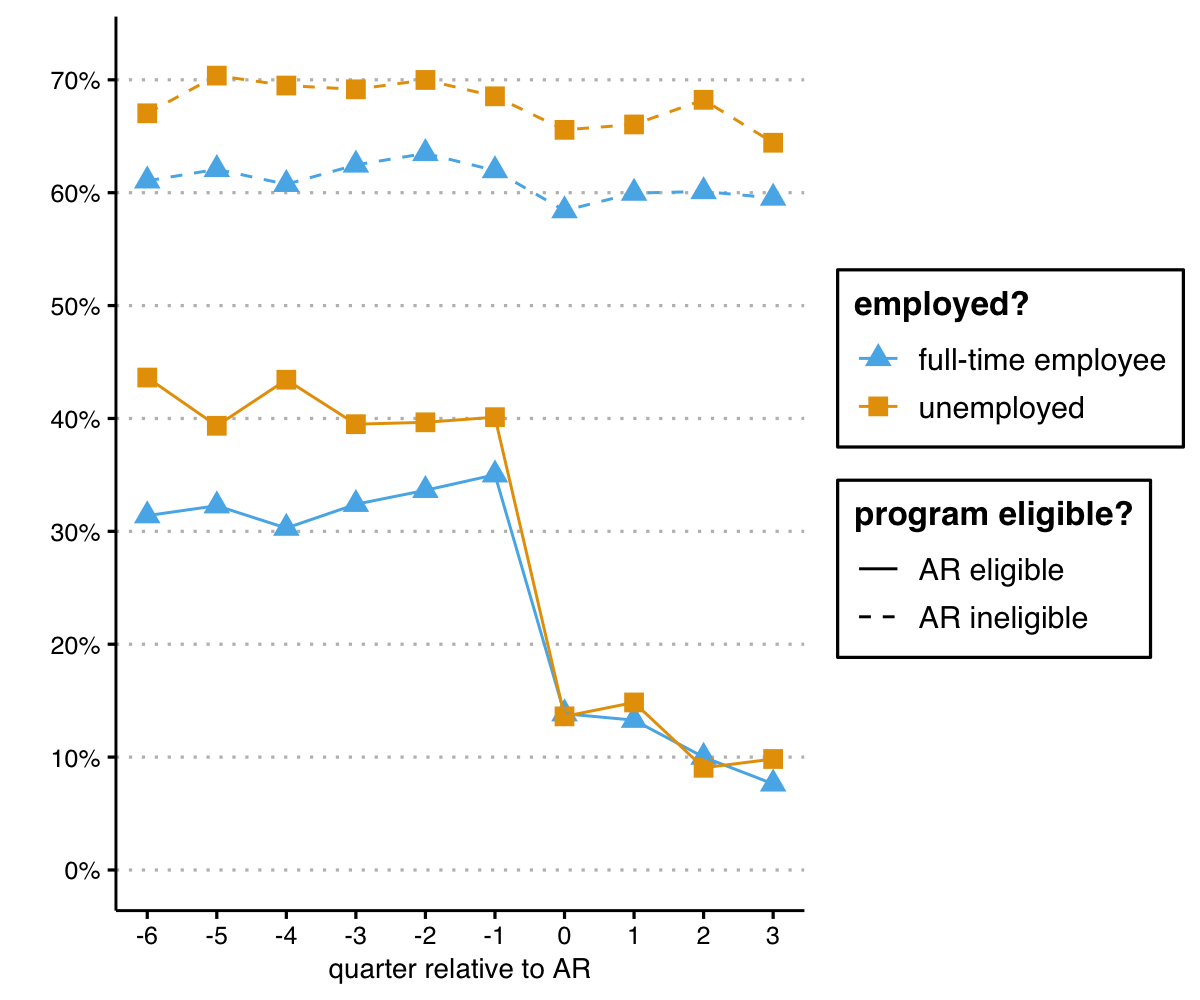 8.4 pp gap => 0.7 pp
8.4 pp gap => 0.7 pp
AR reduces unemployed-employed gaps for eligible cases
 8.4 pp gap => 0.7 pp
8.4 pp gap => 0.7 pp
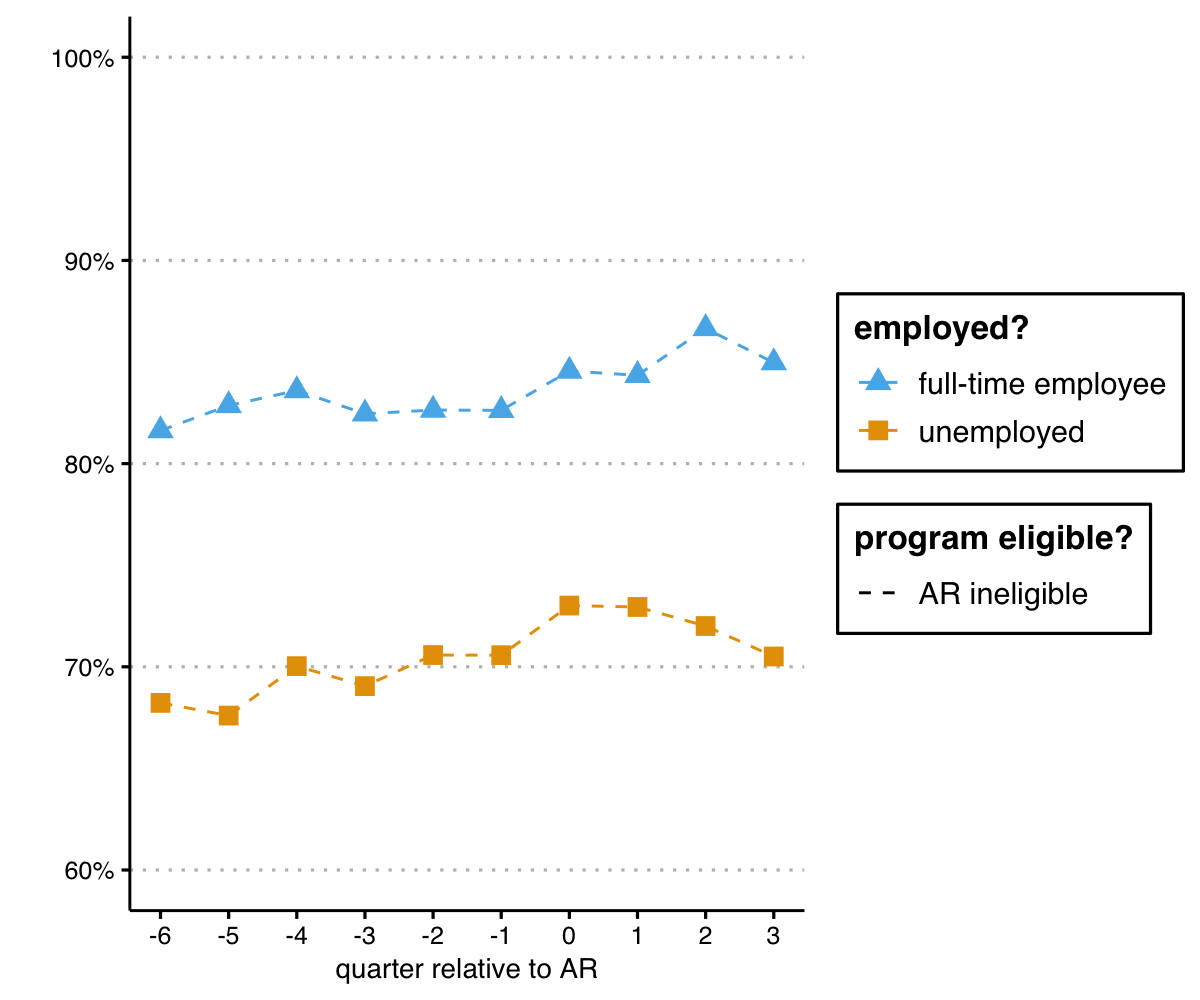
AR reduces unemployed-employed gaps for eligible cases
 8.4 pp gap => 0.7 pp
8.4 pp gap => 0.7 pp
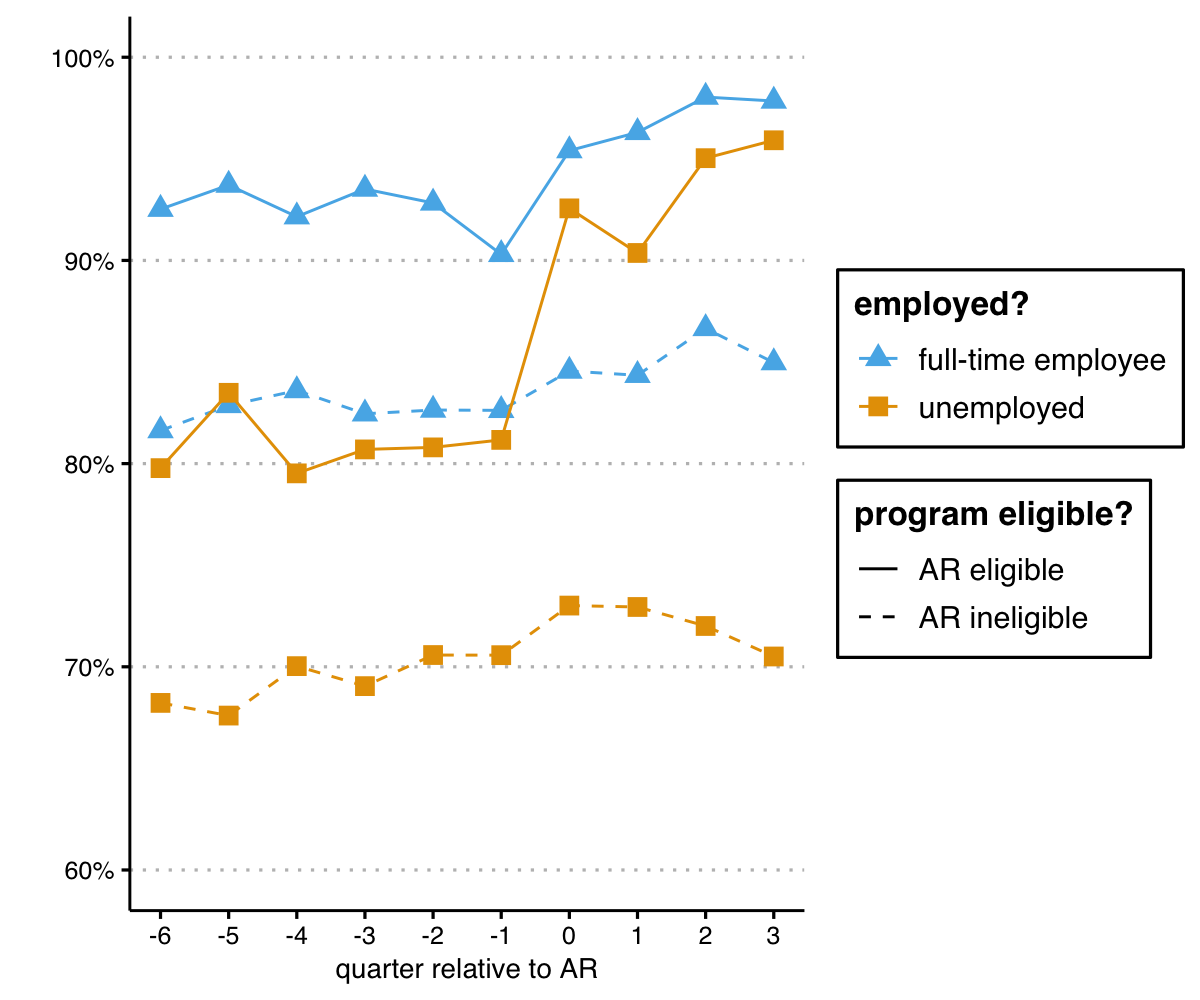 12 pp gap => 3.5 pp
12 pp gap => 3.5 pp
Again, effects are muted for the full population
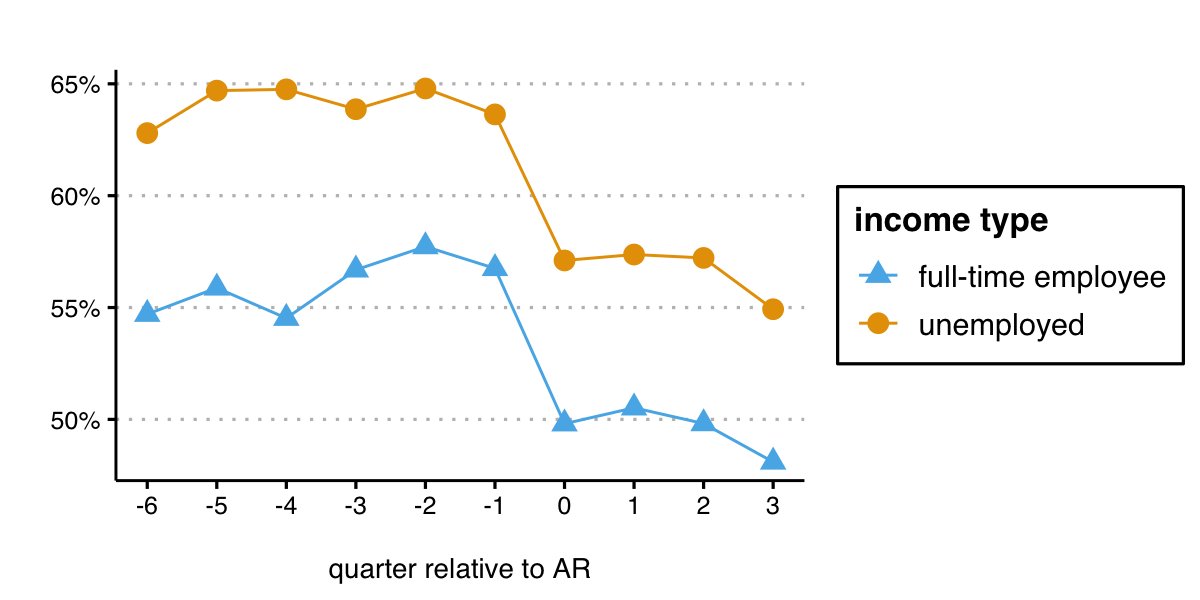
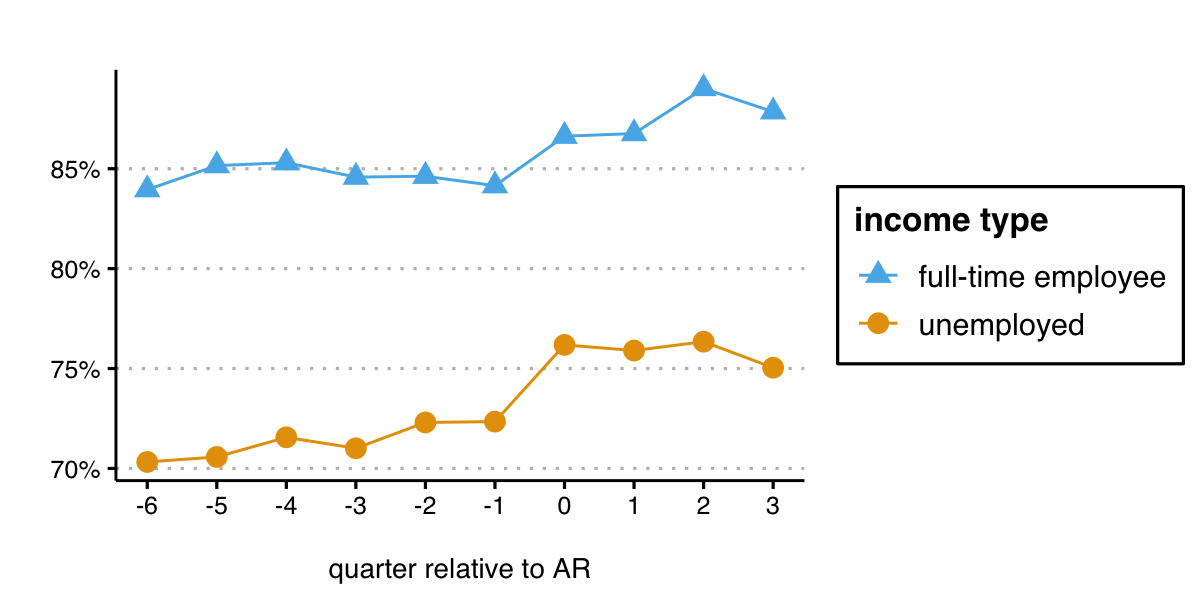
Why?
- only ~21% of cases are AR eligible
- employed people are more likely to be AR eligible (20.6% vs. 18.1%)
- employed people more likely to have regular arrest types,
more likely to have low risk scores
- employed people more likely to have regular arrest types,
I am just showing raw plots since the gaps for ineligible cases stay consistent and my DD results are quite close to what you get from just simple raw plot arithmetic
Mechanisms:
what drives the program effects?
Program effects vs. bail effects
- So far, studying reduced-form effect of the AR program
- Can also use variation to study treatment effects of different bail conditions
Program coverage as an instrument for financial bail conditions (DD-IV) [assumptions]
Program effects vs. bail effects
- So far, studying reduced-form effect of the AR program
- Can also use variation to study treatment effects of different bail conditions
Program coverage as an instrument for financial bail conditions (DD-IV) [assumptions]
Compliers = those spared financial bail by the program
- 27.2% avoid 1+ detention days → DD-IV: 10 pp ↓ financial bail causes a 2.72 pp ↓ in detention
- 6.5% newly fail to appear → DD-IV: 10 pp ↓ financial bail causes a 0.65 pp ↑ in FTA
[deterrence vs. incapacitation effects]
But there are two distinct complier groups
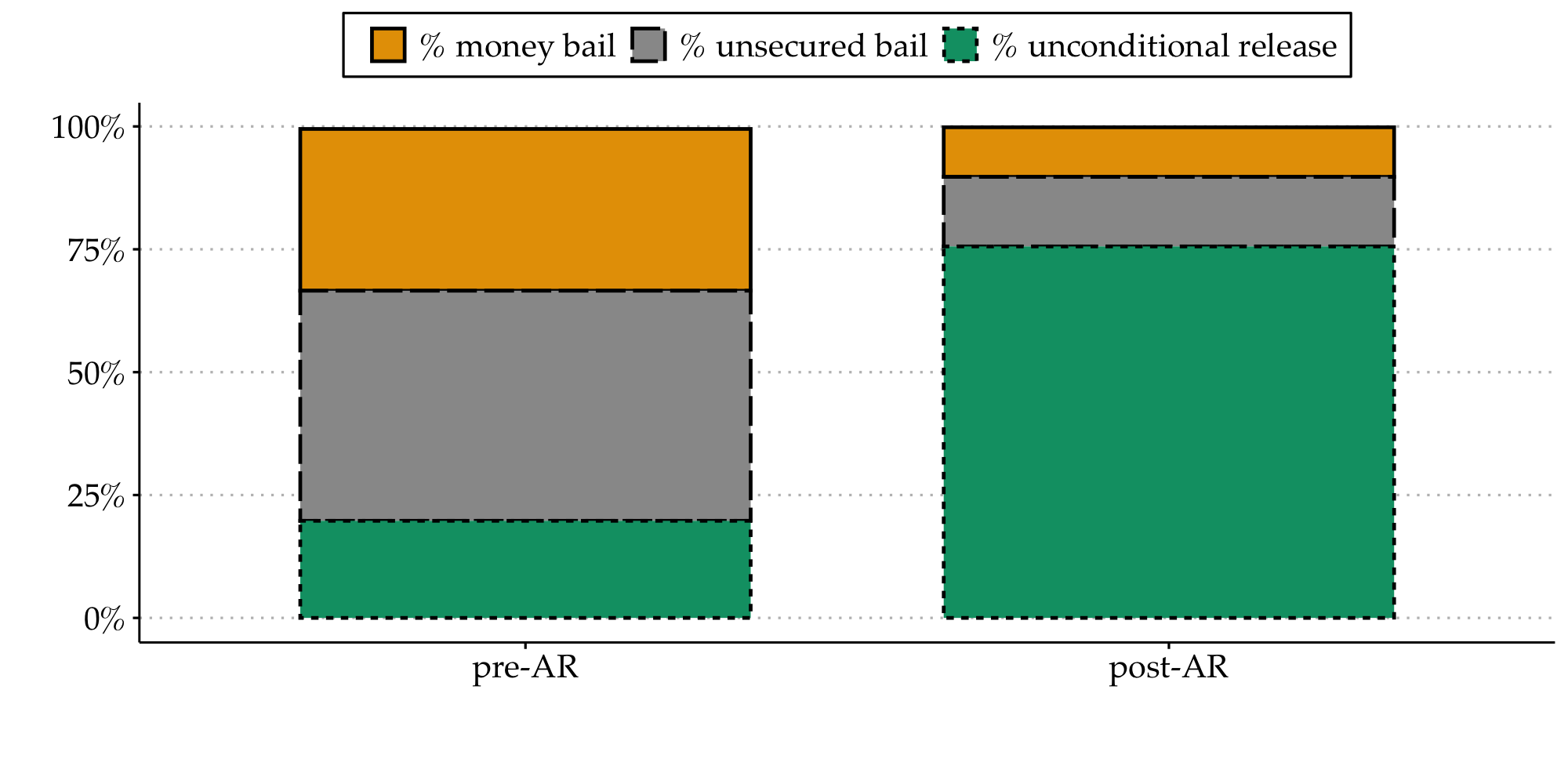
But there are two distinct complier groups
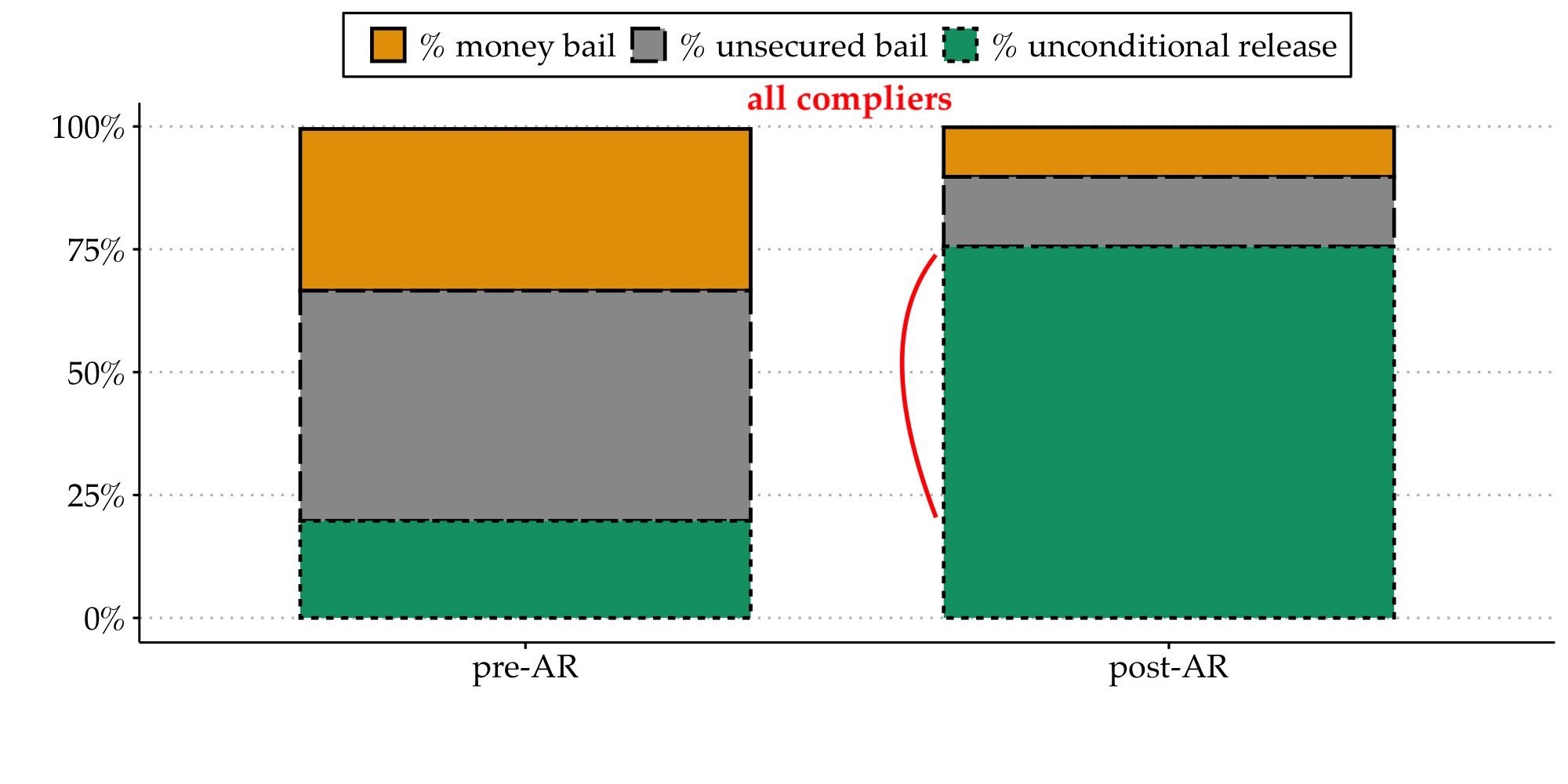
But there are two distinct complier groups

There are two distinct complier groups
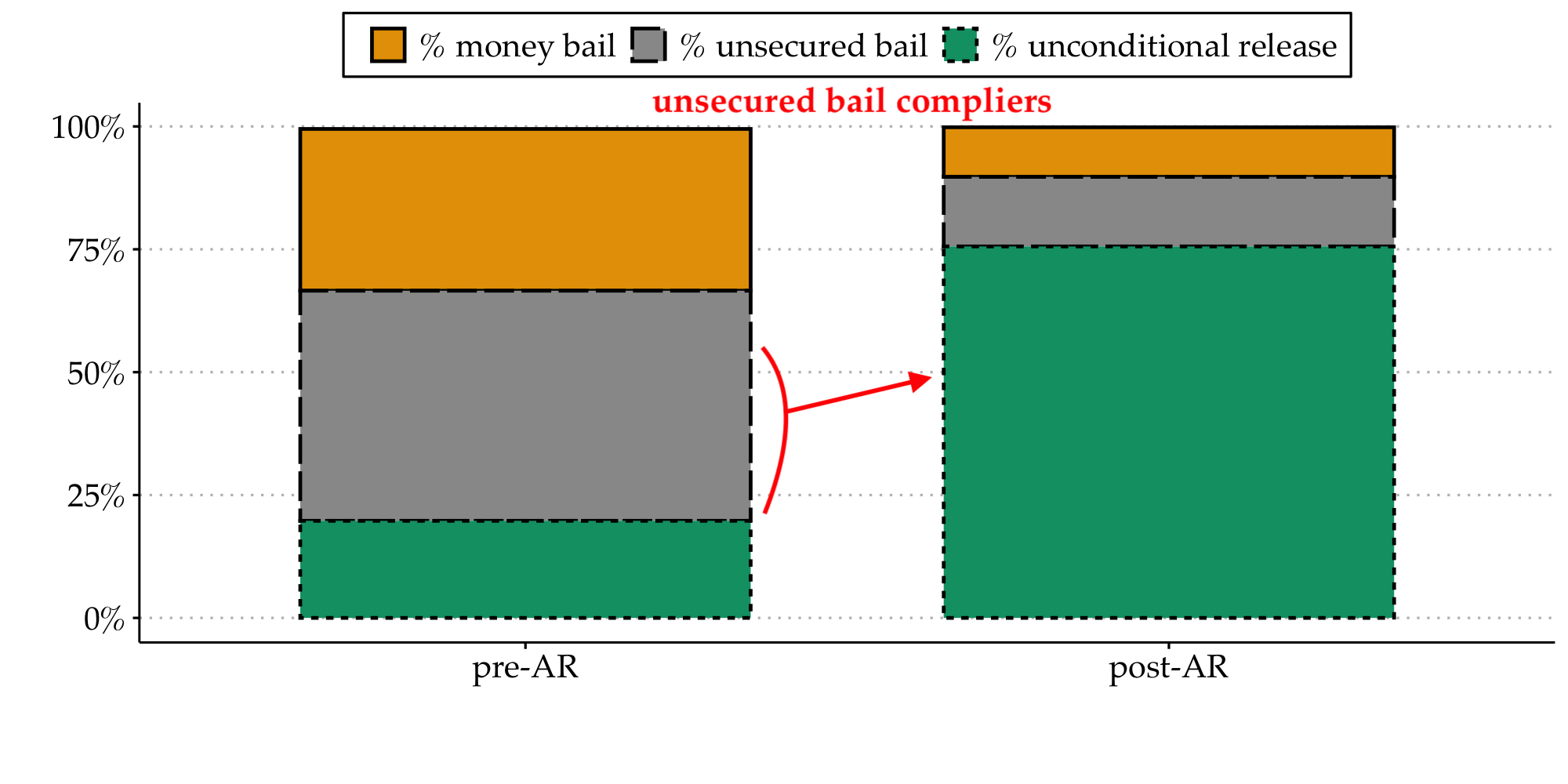
Can I disentangle distinct treatment effects?
I.e., effects of unsecured bail vs. effects of money bail
Use pre-program variation
across counties
(judges vary in their bail setting and are assigned by geography)
Can I disentangle distinct treatment effects?
I.e., effects of unsecured bail vs. effects of money bail
Use pre-program variation
across counties
(judges vary in their bail setting and are assigned by geography)
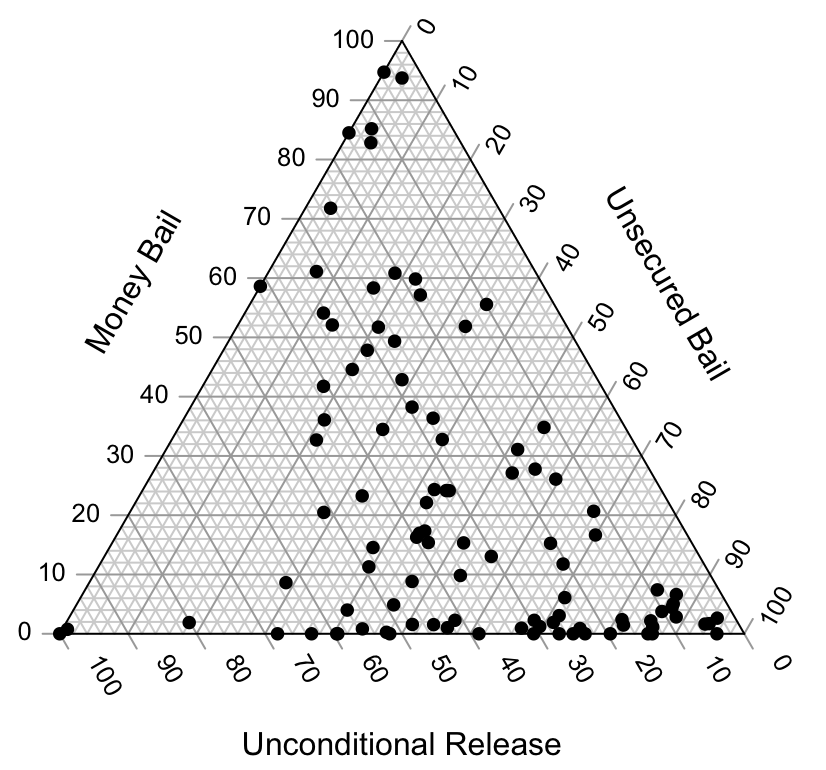
Can I disentangle distinct treatment effects?
I.e., effects of unsecured bail vs. effects of money bail
Use pre-program variation
across counties
(judges vary in their bail setting and are assigned by geography)
- some counties rarely use money bail
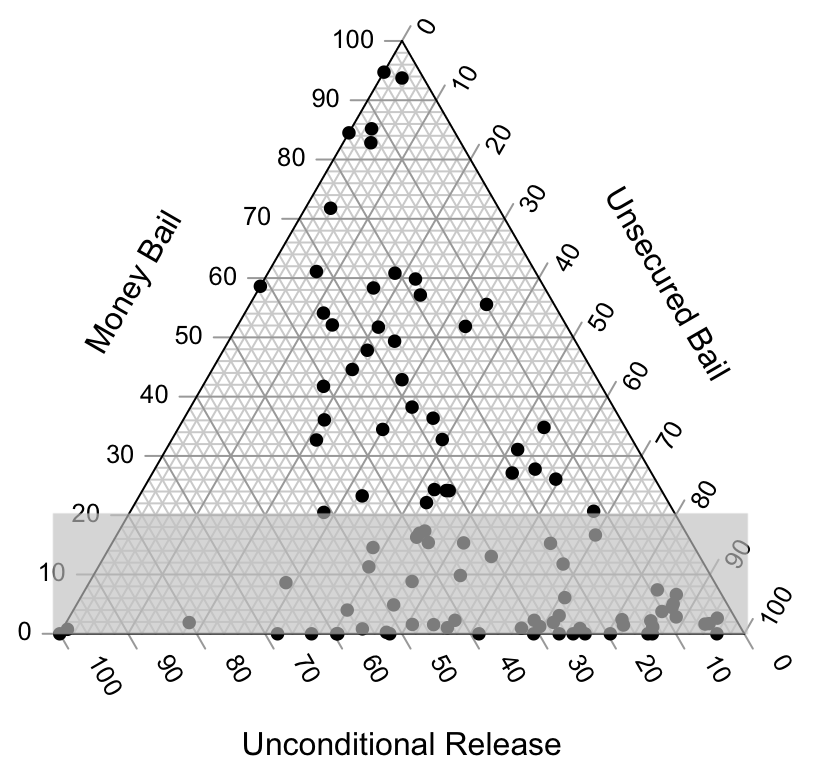
Can I disentangle distinct treatment effects?
I.e., effects of unsecured bail vs. effects of money bail
Use pre-program variation
across counties
(judges vary in their bail setting and are assigned by geography)
- some counties rarely use money bail
- some counties rarely use unsecured bail
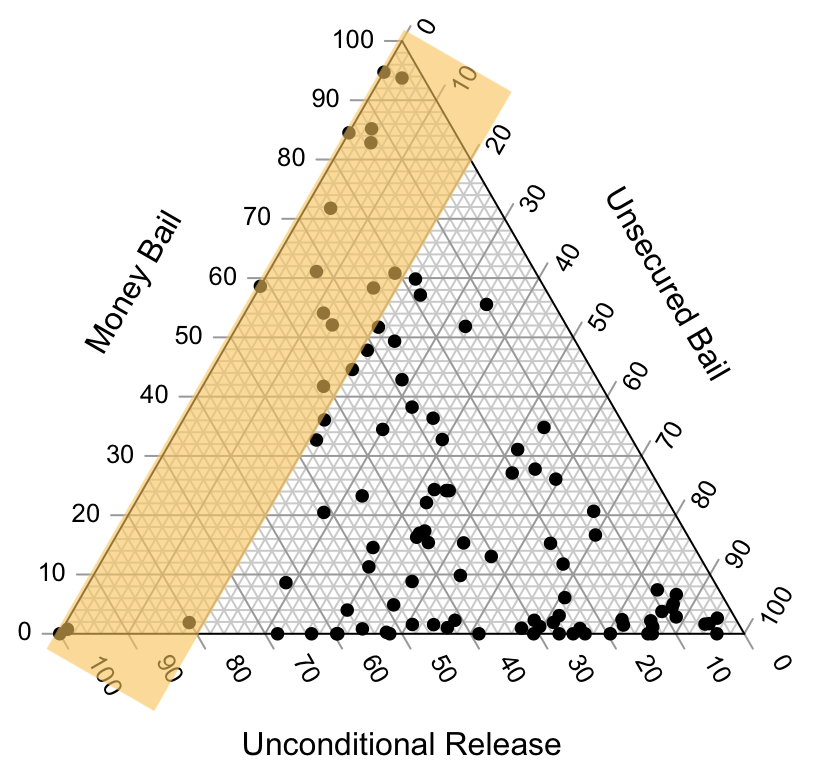
Method 1: Focus on each complier group separately
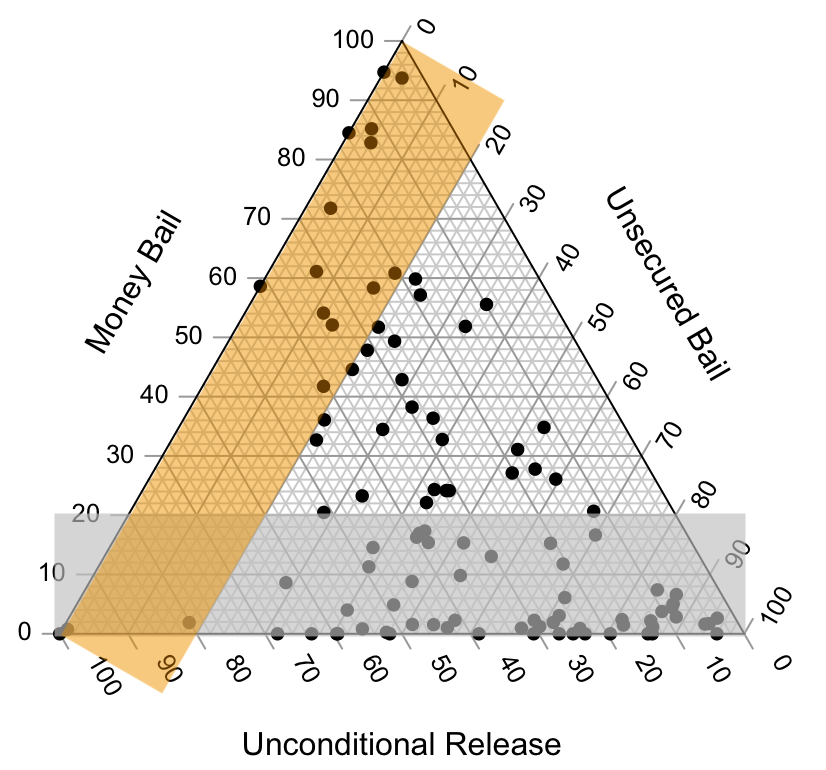
Money bail counties:
unsecured <20% pre-AR
focus on money compliers
Unsecured bail counties:
money bail <20% pre-AR
focus on unsecured compliers
Effects are larger in money bail counties
(misconduct effects near 0 in unsecured bail counties)
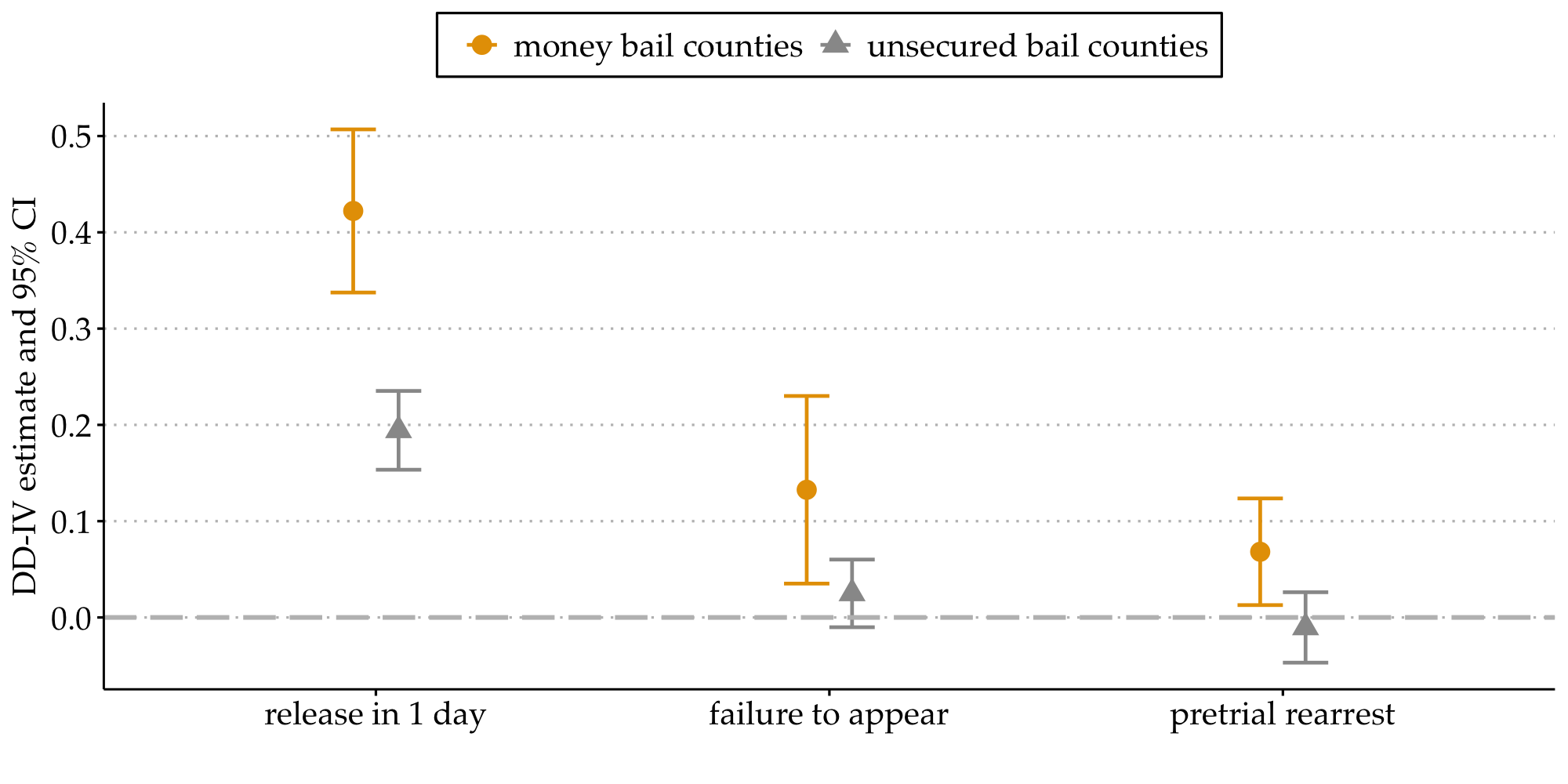
Conclusion
Conclusion
Q: What are the effects of narrowing the use of money bail?
(In my setting, low-level cases; counterfactual = automatic release)
Conclusion
Q: What are the effects of narrowing the use of money bail?
(In my setting, low-level cases; counterfactual = automatic release)
Detention-misconduct trade-off:
- 42% decrease (or 223,000 hours) in detention hours
- 3.3 pp (or 364 instances) increase in court non-appearance
- no detectable increase in pretrial rearrest
Trade-off warranted if 1 non-appearance is less costly than 26 detention days
Conclusion
Q: What are the effects of narrowing the use of money bail?
(In my setting, low-level cases; counterfactual = automatic release)
Detention-misconduct trade-off:
- 42% decrease (or 223,000 hours) in detention hours
- 3.3 pp (or 364 instances) increase in court non-appearance
- no detectable increase in pretrial rearrest
Trade-off warranted if 1 non-appearance is less costly than 26 detention days
Thinking beyond this trade-off:
Program decreases racial and socioeconomic gaps in bail and release
No evidence that program increases new offending
Mechanisms: Program effects mainly from substitution away from money bail
The counterfactual to money bail here is automatic release. In other contexts, if money bail is totally eliminated, that leaves the counterfactual ambiguous -- more people could be detained outright without any bail.
Note bail reform can mean many things: it meant diff things in the 60s from in the 80s. Even today, reforms include many different genres of reforms. Elimination of money bail altogether = distinct from eliminating for low-level offenses and automatically releasing instead. But this is a specific and well-defined program that fits into the broader conversation about reform and abolition.
Thank you for attending!
Feedback?
Come chat with me
or email me:
apalbright@g.harvard.edu
Appendix
Many AR adoption dates across Kentucky's 120 counties
 (AR became mandated statewide in Jan 2017)
(AR became mandated statewide in Jan 2017)
Identification strategy within cohort: differences-in-differences
 (AR became mandated statewide in Jan 2017)
(AR became mandated statewide in Jan 2017)
~90% = doing a pretty good job of tagging eligibility
Full identification strategy

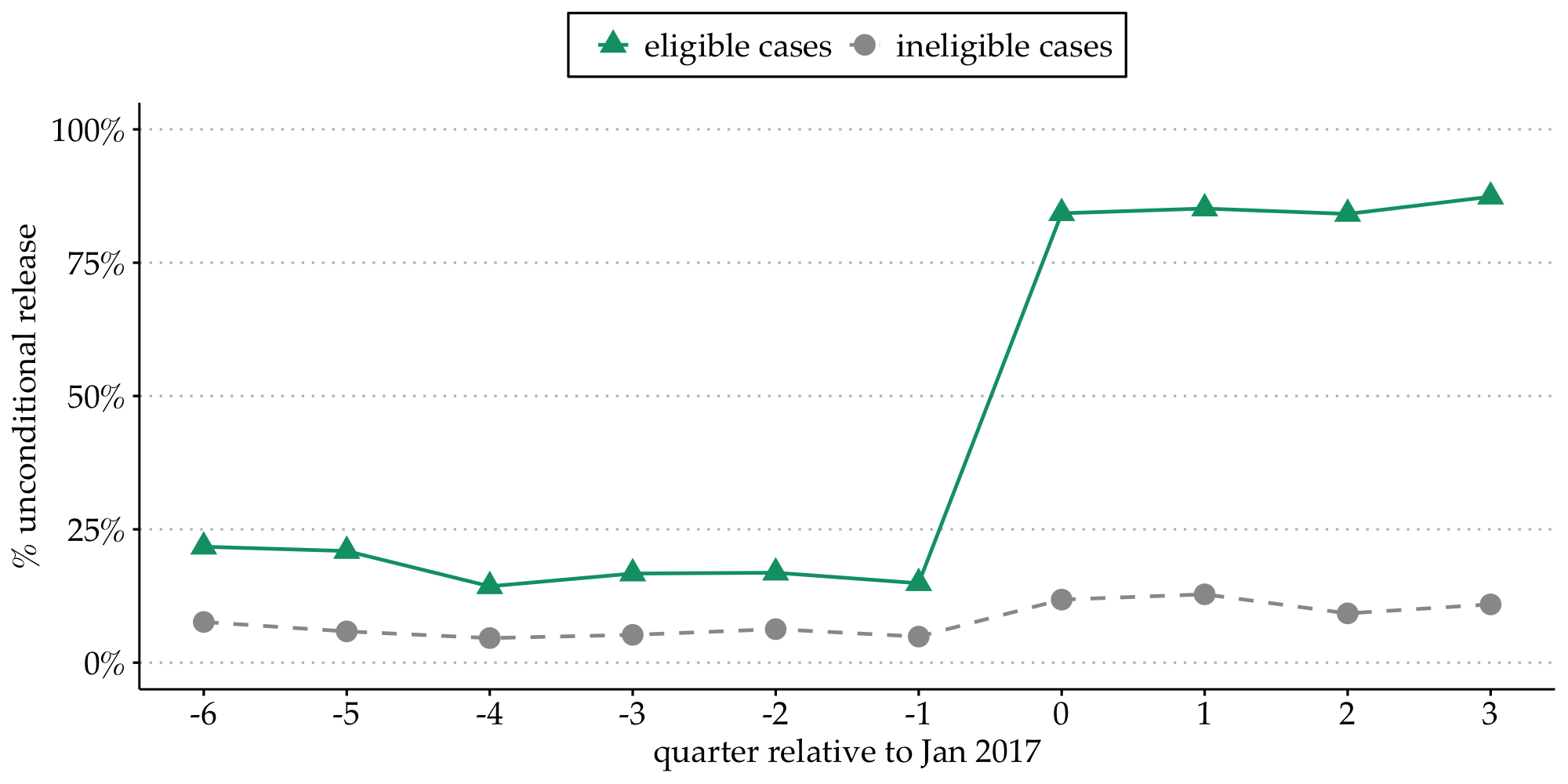
Goal: produce aggregated treatment effect estimates
(using as much data as possible)
Full identification strategy: stacked differences-in-differences
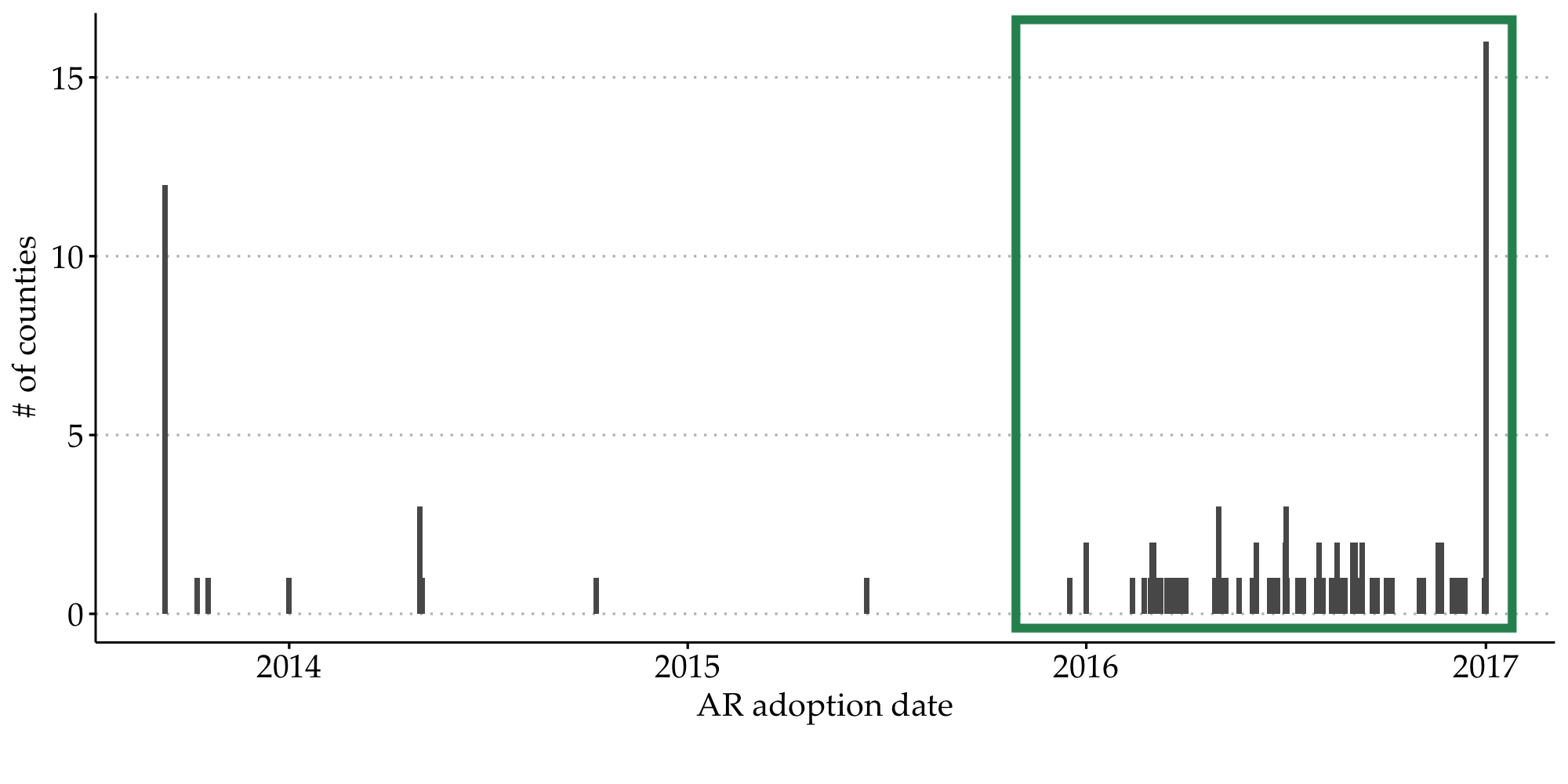

limit to 99 counties limit to q∈[−6,3]
(with consistent eligibility definition) (so same county composition in each q)
TWFE specifications:
yit=βEligiblei+λt+δDD(Postt×Eligiblei)+ϵit
yit=βEligiblei+λt+∑q≠−1δDDq[I[t−AR=q]×Eligiblei]+ϵit
Full identification strategy: stacked differences-in-differences


limit to 99 counties limit to q∈[−6,3]
(with consistent eligibility definition) (so same county composition in each q)
Stacked: saturate TWFE with county indicators c [FAQs][Back]
yitc=βEligibleic+λtc+δDD(Posttc×Eligibleic)+ϵitc
yitc=βEligibleic+λtc+∑q≠−1δDDq[I[t−ARc=q]×Eligibleic]+ϵitc
tl;dr just a way of averaging 99 county-level 2x2 DDs
Heterogeneity by offense type?
Suggestive evidence of opposing directions for later periods by offense type
asinh(AR eligible arrests)
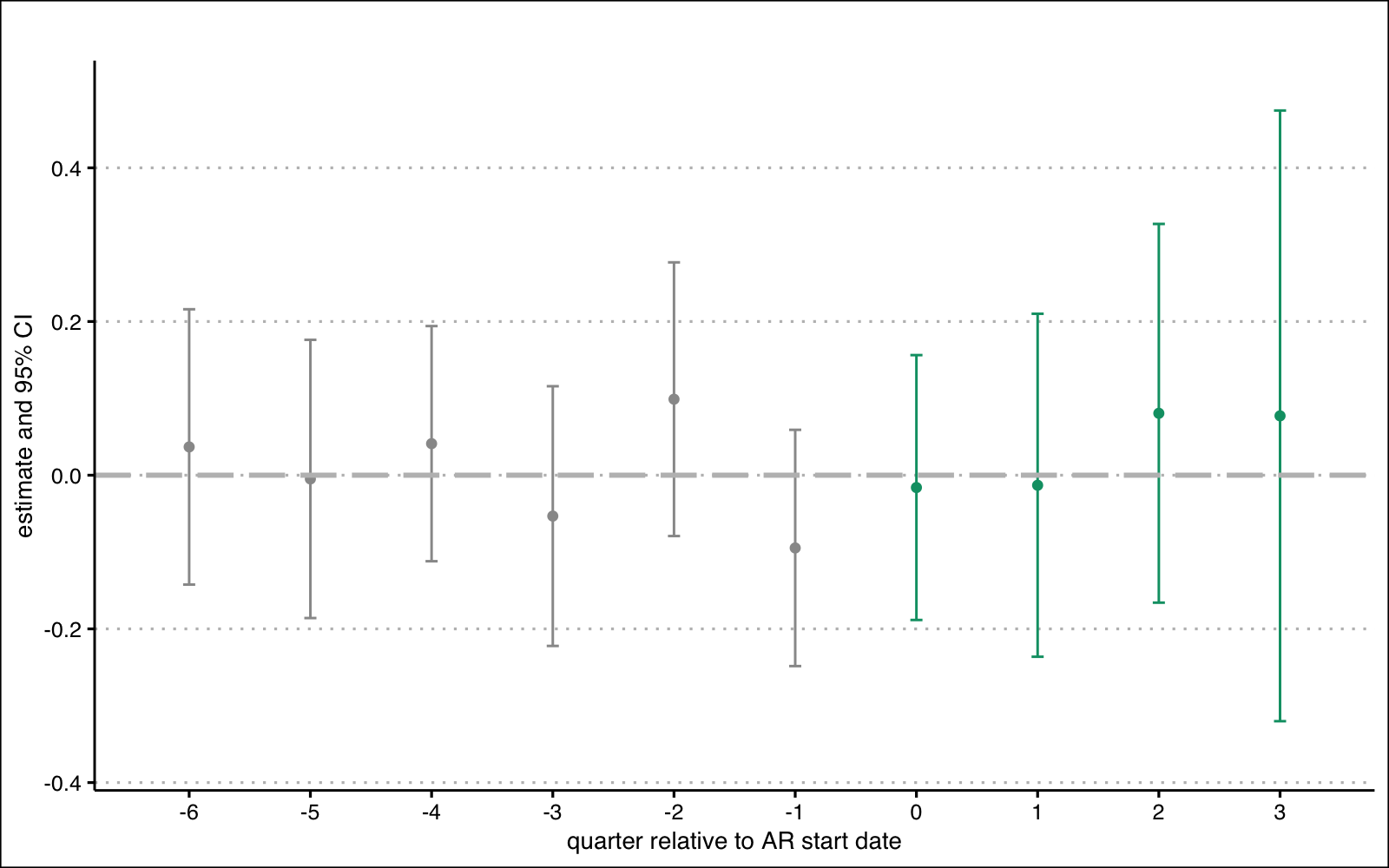
asinh(AR ineligible arrests)
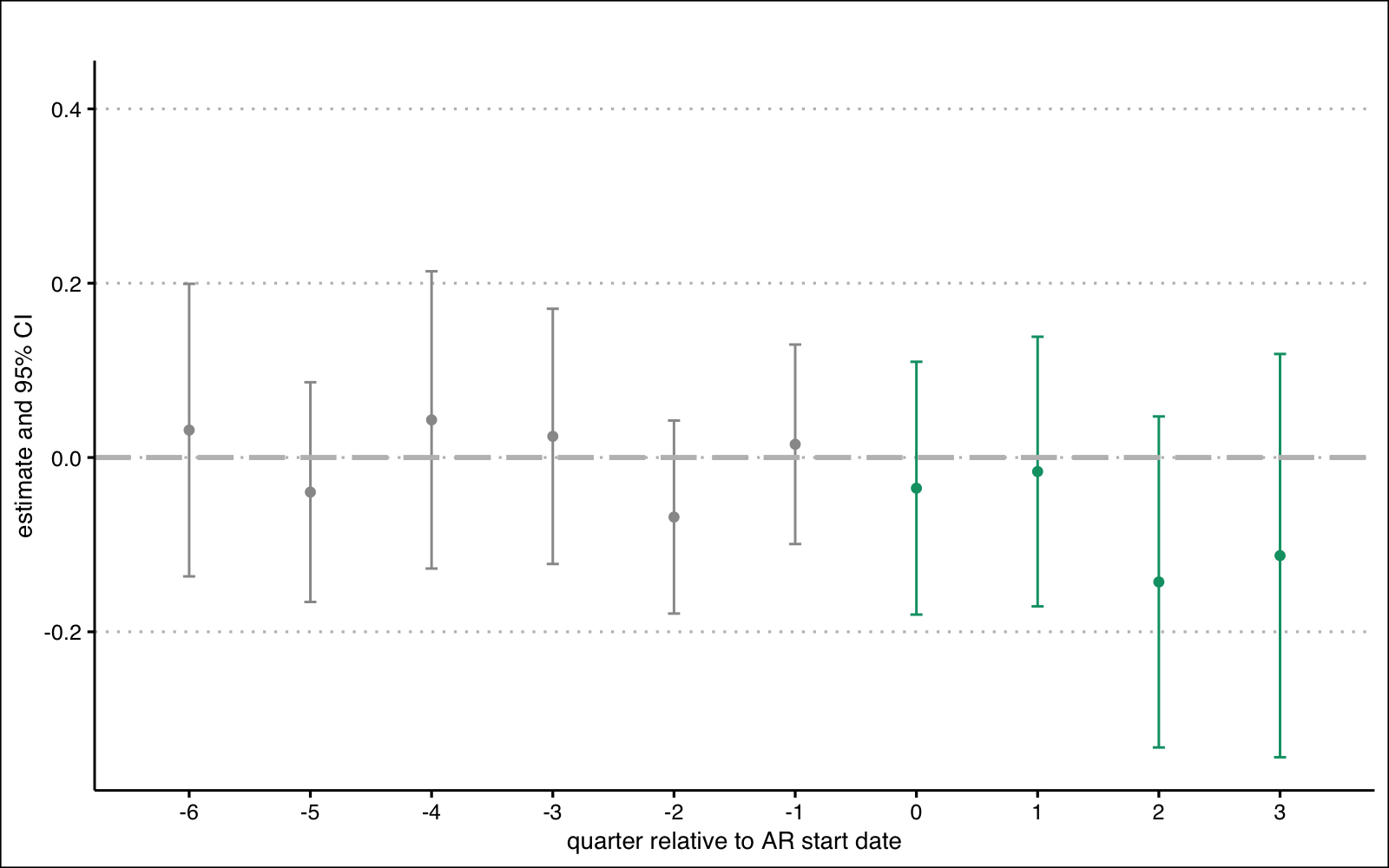
- Callaway and Sant'Anna approach to deal with issues with TWFE
- Similar results for not-yet-treated units and last treated units as control group
There seems to be some substitution in later time periods away from ineligible cases.
In later periods, substitution across offense types
(is this a change in offending or a change in charging practices?)
Method 2: leverage continuous variation across counties
Instead of just using "extreme counties"...

Method 2: leverage continuous variation across counties
Instead of just using "extreme counties"...

Use them all:

Method 2: leverage continuous variation across counties
2SLS w/ 2 endogenous variables: unconditional release & unsecured bail (following Kline + Walters 2016)
Method 2: leverage continuous variation across counties
2SLS w/ 2 endogenous variables: unconditional release & unsecured bail (following Kline + Walters 2016)
Generate a series of instruments: Zi×Xi
(Kling, Liebman, Katz 2007; Abdulkadiroglu, Angrist, + Pathak, 2014)
In my case: post x eligible interacted with county indicators
Method 2: leverage continuous variation across counties
2SLS w/ 2 endogenous variables: unconditional release & unsecured bail (following Kline + Walters 2016)
Generate a series of instruments: Zi×Xi
(Kling, Liebman, Katz 2007; Abdulkadiroglu, Angrist, + Pathak, 2014)
In my case: post x eligible interacted with county indicators
Identification under constant effects framework (Hull, 2014)
I.e., counterfactual-specific effects don't vary by counties
Intepreting results: 2SLS with county interaction instruments
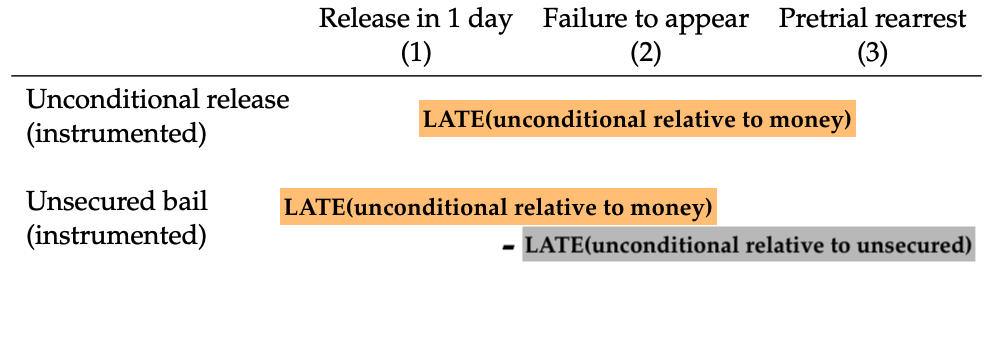
Intepreting results: 2SLS with county interaction instruments
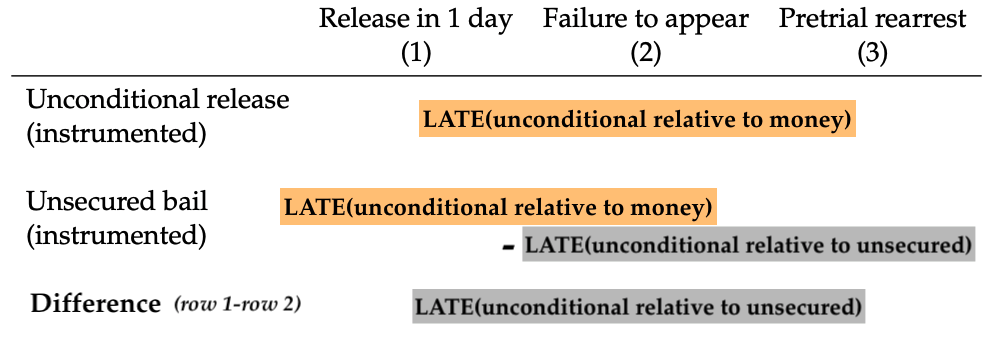
Money bail does matter more than unsecured bail
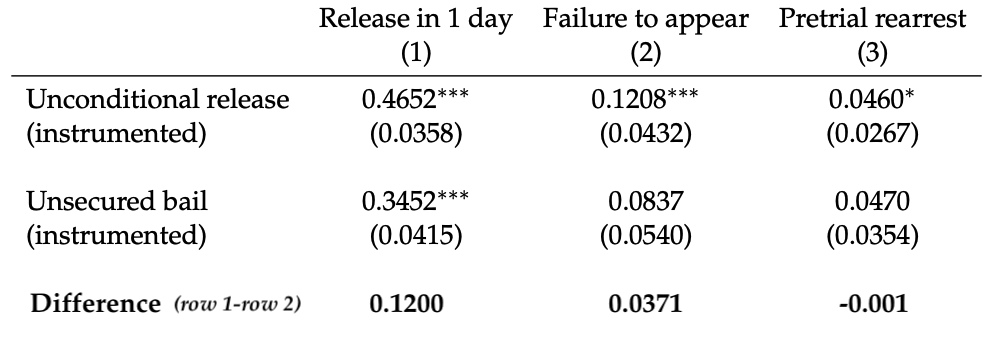
Money bail does matter more than unsecured bail
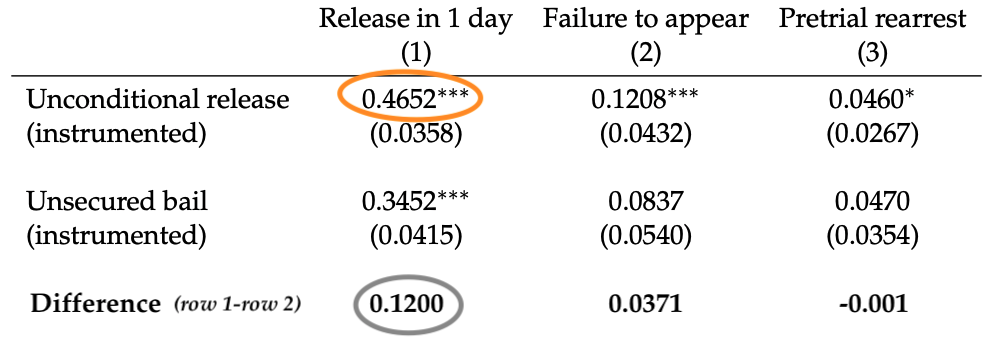
- Money bail effects are ~3.8 times as large for release
Money bail does matter more than unsecured bail

- Money bail effects are ~3.8 times as large for release and ~4 times as large for failure to appear
Money bail does matter more than unsecured bail
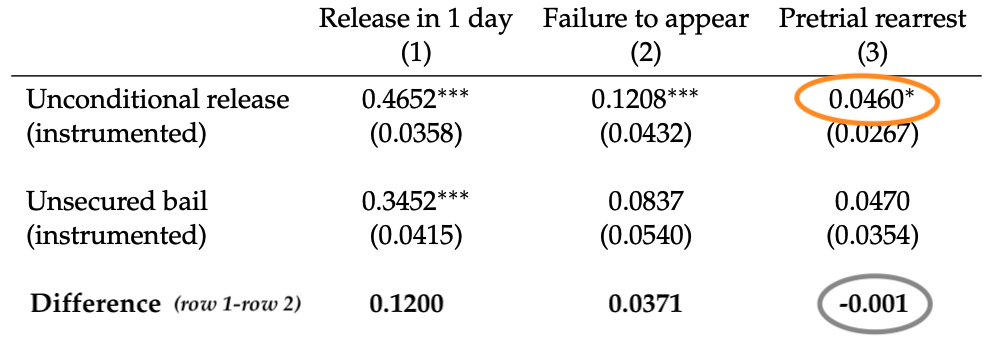
- Money bail effects are ~3.8 times as large for release and ~4 times as large for failure to appear
- Unsecured bail effects for pretrial rearrest are ~0 [details]
Attempting to change bail system is not new
1960s: focus on alternatives to money bail system (parallels to today)
- encourage least restrictive conditions (+ presumptions favoring recognizance) (The Bail Reform Act of 1966 (state statutes follow suit)
- 60's: civil rights + poverty + bail (creation of: Committee on Poverty and the Admin of Federal Criminal Justice, Vera Foundation, 1st National Conference on Bail and Criminal Justice)
1970s-1980s: intention of bail extended
- pre-1970: court appearance only valid purpose for limiting freedom
- public safety becomes a valid reason to limit freedom (DC Court Reform + Criminal Procedure Act of 1970; states follow suit; Congress passed the Bail Reform Act of 1984)
(Schnacke, 2014)
Pretrial Fairness Act in Illinois
It became increasingly clear [...] that a more binding, statewide policy change was needed. [The act creates] bright-line rules that [take] away carceral tools from judges instead of trusting them to use such tools sparingly
Bail type frequency for felony defendants nationally

(32% detained on money bail) (Reaves + Cohen, 2007) [Back]
National facts about release and bail amounts
Felony defendants in 75 largest US counties (1990-2004) (Reaves+Cohen, 2007)
62% released prior to case disposition
- 50% of releases within 1 day of arrest
- 75% within 1 week
Median bail amount = $9,000
Mean = $35,800
National facts about release and misconduct
Release on financial conditions became more common than unconditional release
Misconduct rates: 23% fail to appear, 17% arrested on new offense
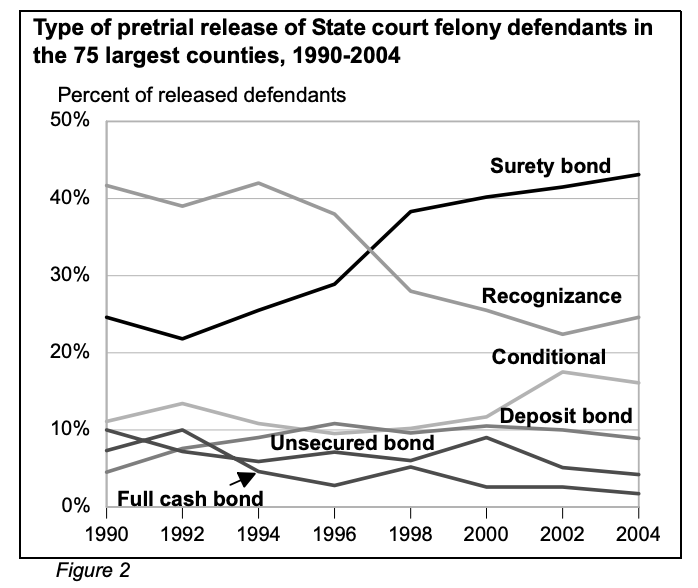
(Reaves+Cohen, 2007)
Pretrial process variation in the US
Bail decision logistics varies:
- time to first bail decision varies: 12-48 hours by place; can take place in person/over video/over the phone
- defendant may/may not be present; prosecutors may/may not have a role
Payment systems vary:
- all but 4 states (Kentucky included) but have commercial bail bonds industries
- bail bonds companies front the bail amount (non-refundable fee: ~10% of the total)
Bail FAQs
What happens if I don't show?
- Warrant for arrest; will now be treated more harshly since arrest for original offense as well as failure to appear in court
- If no show with money bail or unsecured bond, can forfeit money amount to court (otherwise, returned)
What if I can't afford money bail?
- Variation across counties/states in subsidizing money bail:
- Commercial bail bonds industry with non-refundable fee (~ 10% of total) (e.g., CA)
- Partial deposit systems (e.g., Kentucky)
- Non-profit orgs that post bail on behalf of defendants (e.g., Brooklyn Bail Fund)
- If still can't afford money bail, detained pretrial
Other sorts of bail conditions
Some bail reforms accompanied by shifts to new sorts of non-financial but strict-ish release: e.g., supervision/EM.
- In my data: only a handful of observations with electronic monitoring & <1% with supervision
Main bail conditions (ROR, unsecured bail, money bail) can be supplemented w/ extra requirements (if violate, can be rearrested):
no driving, no alcohol drugs, no weapon possess, no contact defendant, drug/alcohol evaluation, keep job, mental health eval, drug treatment, don't return to location of offense, no alcohol or controlled substances, no contacting codefendants, notify of change of address, no contact with minors or children
Why do <100% eligible cases get unconditional release after AR?
Eligibility tagging imperfections:
- Before Jan 1, 2017, charge code from narrative record used for determining eligibility (I only observe charge code assigned by law enforcement)
- People arrested on a criminal warrant with a listed bail amount are ineligible (whether they are arrested in this way is unobservable to me)
Imperfect implementation:
Before 2017, implementation was "messy" (according to interviews with staff)
→ standardized in 2017 (when the program went statewide)
More on warrants with bail amounts
"If the judge enters a bail amount on a warrant we cannot release on AR we have to present these"
- In KY, anyone can file a criminal complaint with the prosecutor’s office (includes police officers, businesses and private citizens)
- Citizen makes an allegation and signs a sworn statement
- The prosecutor then requests that the court issue a summons or a warrant or declines to do either
- The judge then makes the decision to issue a warrant or a summons, sometimes they list an amount for the warrant
AR eligible charges that are "common circumstances" for criminal warrant arrests: theft and harassment
Stacked differences-in-differences
When using for staggered timing (Baker, Larker, Wang 2022, Cengiz et al. 2019)
- create clean 2x2 datasets
- researcher generates dataset-specific identifying variable
- stack them together
- estimate TWFE DD regression with dataset-specific unit- and time-fixed effects
In my case, the clean datasets are just subsets by county
(data is already stacked, and I already have an indicator (county))
Why not use Callaway and Sant'Anna (2020)?
Estimate group-time average treatment effects under unconditional parallel trends
- groups defined by program date (rounded down to nearest month): 14 groups
- these are eligible cases grouped by county AR date
- control group = ineligible cases ("never treated")
Why not use Callaway and Sant'Anna (2020)?
Estimate group-time average treatment effects under unconditional parallel trends
- groups defined by program date (rounded down to nearest month): 14 groups
- these are eligible cases grouped by county AR date
- control group = ineligible cases ("never treated")
Issue: the control group for eligible cases in 1 county group =
the ineligible group in ALL counties
Callaway and Sant'Anna (2020) does not align with variation I should leverage → Stacked DD does
Callaway and Sant'Anna (2020) Specifics
Under unconditional parallel trends, never treated = controls, no anticipation:
For all g=2,...,τ, and t=2,...,τ with t≥g,
ATT(g,t)=E[Yt−Yg−1|Gg=1]−E[Yt−Yg−1|C=1] Let e=t−g be event-time. To show treatment effects over event-time:
θes(s)=∑g∈G1{g+e≤τ}P(G=g|G+e≤τ)ATT(g,g+e)
Average treatment effect averages all identified ATT's together
θOW=1κ∑g∈Gτ∑t=21{t≥g}ATT(g,t)P(G=g|G≤τ)s.t.κ=∑g∈Gτ∑t=21{t≥g}P(G=g|G≤τ)
$ required for release ↓ 77% (continuous outcomes variable)
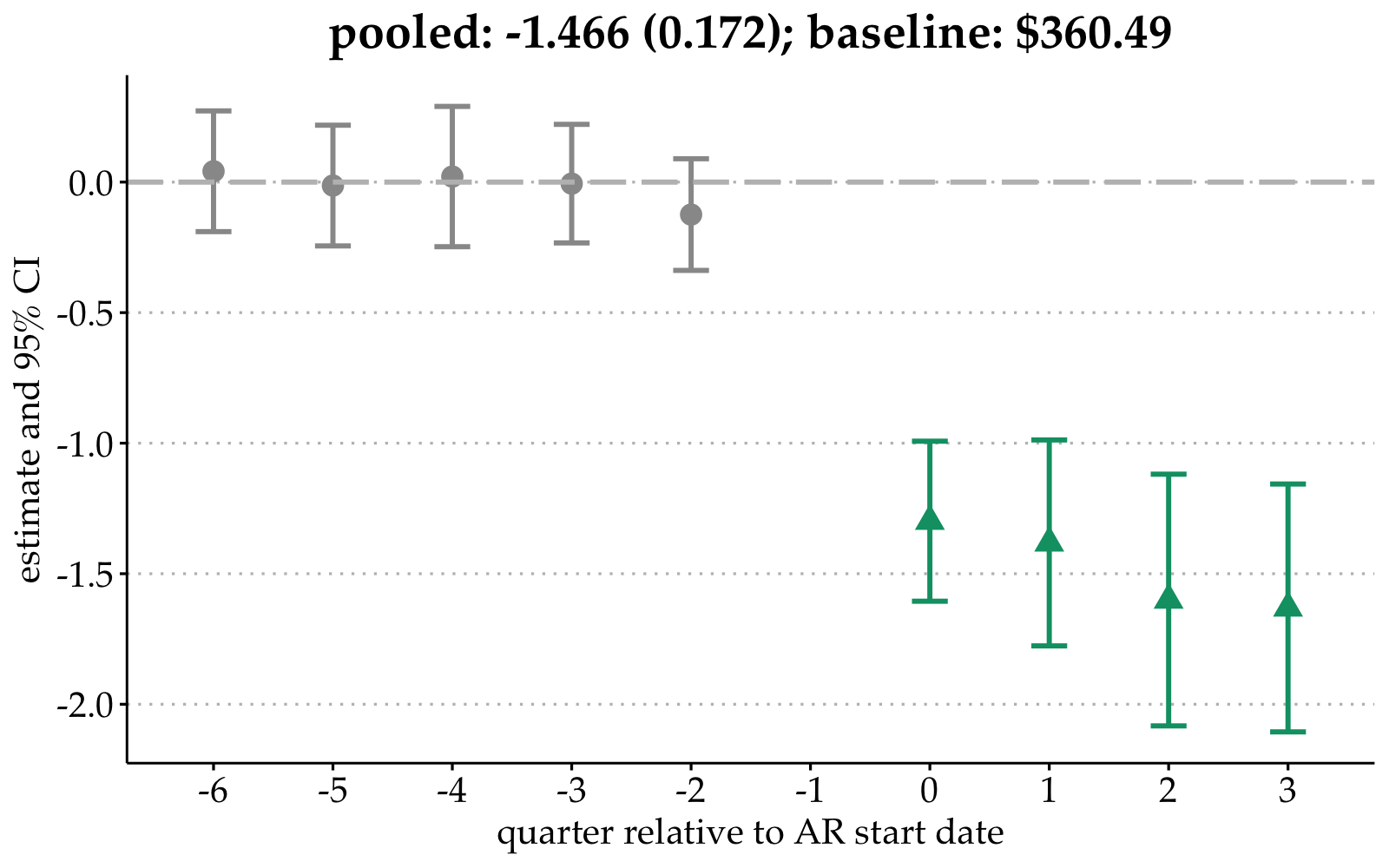
Percentage change in y is approximated: (exp(^β)−1)×100 (Bellemare and Wichman, 2019) [Back]
Hours in detention ↓ 42% (continuous outcomes variable)
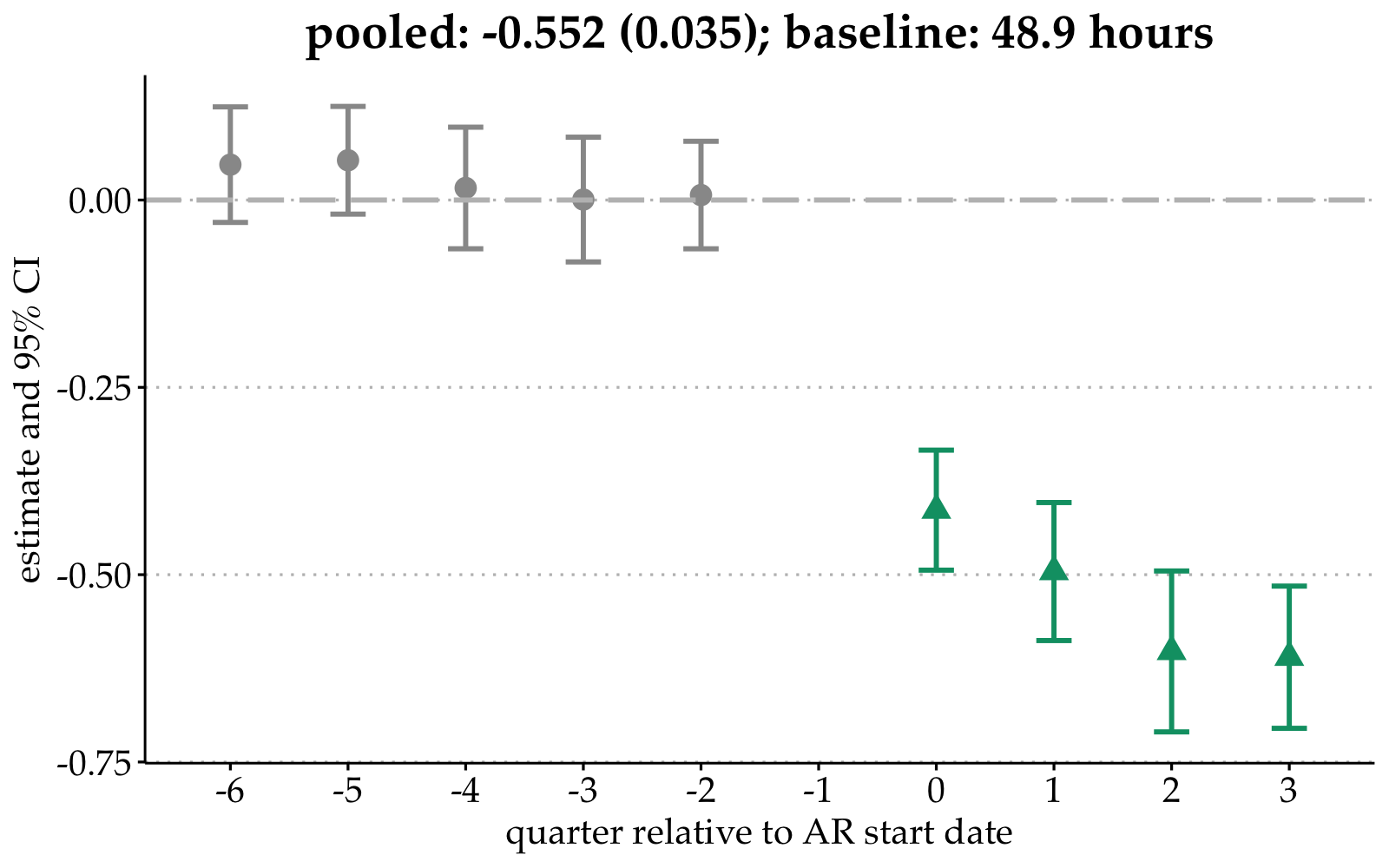
Percentage change in y is approximated: (exp(^β)−1)×100 (Bellemare and Wichman, 2019) [Back]
Extended monotonicity assumption, formally
Zi∈{0,1}: whether case i covered by AR (post and eligible)
Bi(Zi)∈{unconditional, unsecured, money}:
potential bail type for case i
Assumption: Bi(1)≠Bi(0)→Bi(1)=unconditional
Only sort of change in bail types due to AR = switches to unconditional release
Testing exclusion for release in 1 day
For eligible group already receiving unconditional release (always takers): release within 1 day before and after increase by 4 percentage points
For eligible group not receiving unconditional release before (compliers): 25 percentage point increase in release within 1 day (assuming they are in the unconditional release group after)
Estimate compliers (who are 60% of the population) get a 25 ppt increase and always-takers (who are 20% of the population) experience a 4 ppt increase
→ aligns with the estimated 15 ppt increase since 0.04 ∗ 0.2 + 0.25 ∗ 0.6 ≈ 0.15.
The complier change is responsible for 95% of the effect
since 0.25 ∗ 0.6/(0.25 ∗ 0.6 + 0.25 ∗ 0.6) ≈ 0.95
How much does deterrence and/or incapacitation contribute?
Conditions generate simultaneous changes in deterrence (less bail conditions) and incapacitation (more people released)
How much does deterrence and/or incapacitation contribute?
Conditions generate simultaneous changes in deterrence (less bail conditions) and incapacitation (more people released)
Accounting exercise: relative importance of deterrence/incapacitation depends on marginal risk of newly released people
(compliers--in terms of conditions--split into subgroups based on release)
If newly released have
- same FTA rate (as always takers), deterrence is ~81% of the effect
- 3 x as large FTA rate (as always takers), deterrence is ~50% of the effect
- ~6 x as large FTA rate (as always takers), deterrence ~0% of the effect
Deterrence vs incapacitation: bounding exercise
Misconduct is only possible if defendants are out of pretrial detention before case disposition (case conclusion)
Before the program,
- 88.6% of eligible defendants are released before disposition
- 19.6% receive unconditional release (and are released before disposition)
- meaning a remaining 69% of eligible defendants receive financial bail conditions but are also released
I can write the failure to appear (FTA) rate in the pre-period as a weighted average of FTA rates across these two groups:
FTApre=0.196(FTA|u,r,pre)FTA rate for unconditional released pre-AR+0.69(FTA|∼u,r,pre)FTA rate for released with financial conditions pre-AR
Deterrence vs incapacitation: bounding exercise
After AR, unconditional release is 50.5 p.p. higher for the eligible group, release before disposition is 7.6 p.p. higher → more people are mechanically able to commit misconduct
Assuming that all the newly released defendants are newly released due to unconditional release receipt, I break down the post-AR FTA rate such that weights sum to the new total of people released pre-disposition as:
FTApost=0.196(FTA|u,r)always takers+0.47(FTA|u,r)compliers, previously released+0.076(FTA|u,r)compliers, previously detained+0.216(FTA|f,r)never takers
Assume that the always takers and never takers commit FTA at the same rates as they did before.
Then, the change in the FTA rate is attributable to the change in FTA for compliers who no longer have financial conditions and the FTA rate for those who are now released (since they were previously detained their pre-FTA rate is assumed to be 0)
Deterrence vs incapacitation: bounding exercise
These changes in rates multiplied by the relative share of the population correspond to deterrence and incapacitation effects, relatively.
ΔFTA=FTApost−FTApre=0.05=0.47((FTA|u,r)−(FTA|f,r))compliers, previously released+0.076(FTA|u,r)compliers, previously detained
Assume (FTA|u,r)compliers, previously detained≥0.125 ( FTA|f,r,pre)=0.125 )
Assuming those previously detained are at least as likely to fail to appear than we can assume (FTA|u,r)compliers, previously released,(FTA|u,r)compliers, previously detained≥0.125.
Deterrence vs incapacitation: bounding exercise
Accounting exercise: relative importance of deterrence/incapacitation depends on marginal risk of newly released people
(compliers--in terms of conditions--split into subgroups based on release)
If newly released have
- same FTA rate (as always takers), deterrence is ~81% of the effect
- 3 x as large FTA rate (as always takers), deterrence is ~50% of the effect
- ~6 x as large FTA rate (as always takers), deterrence ~0% of the effect
